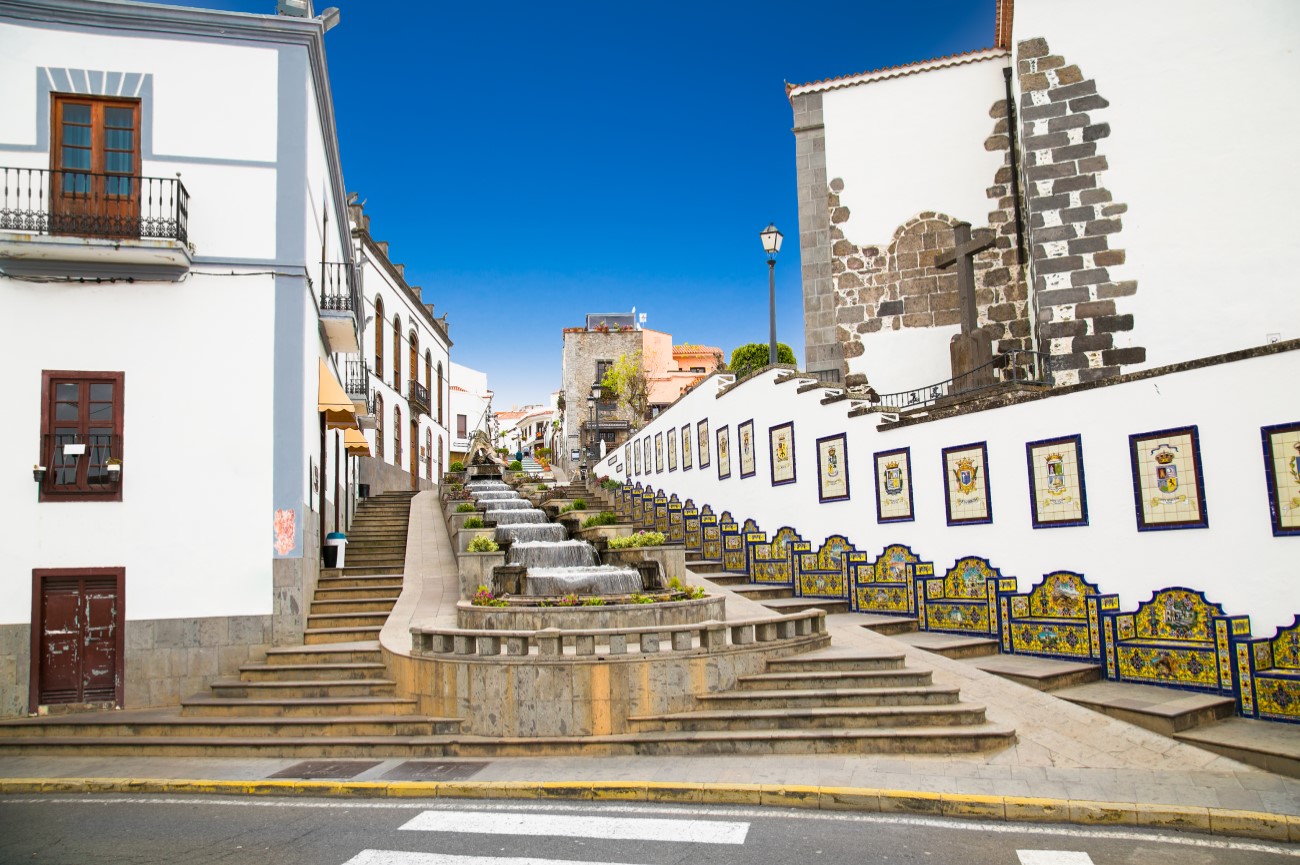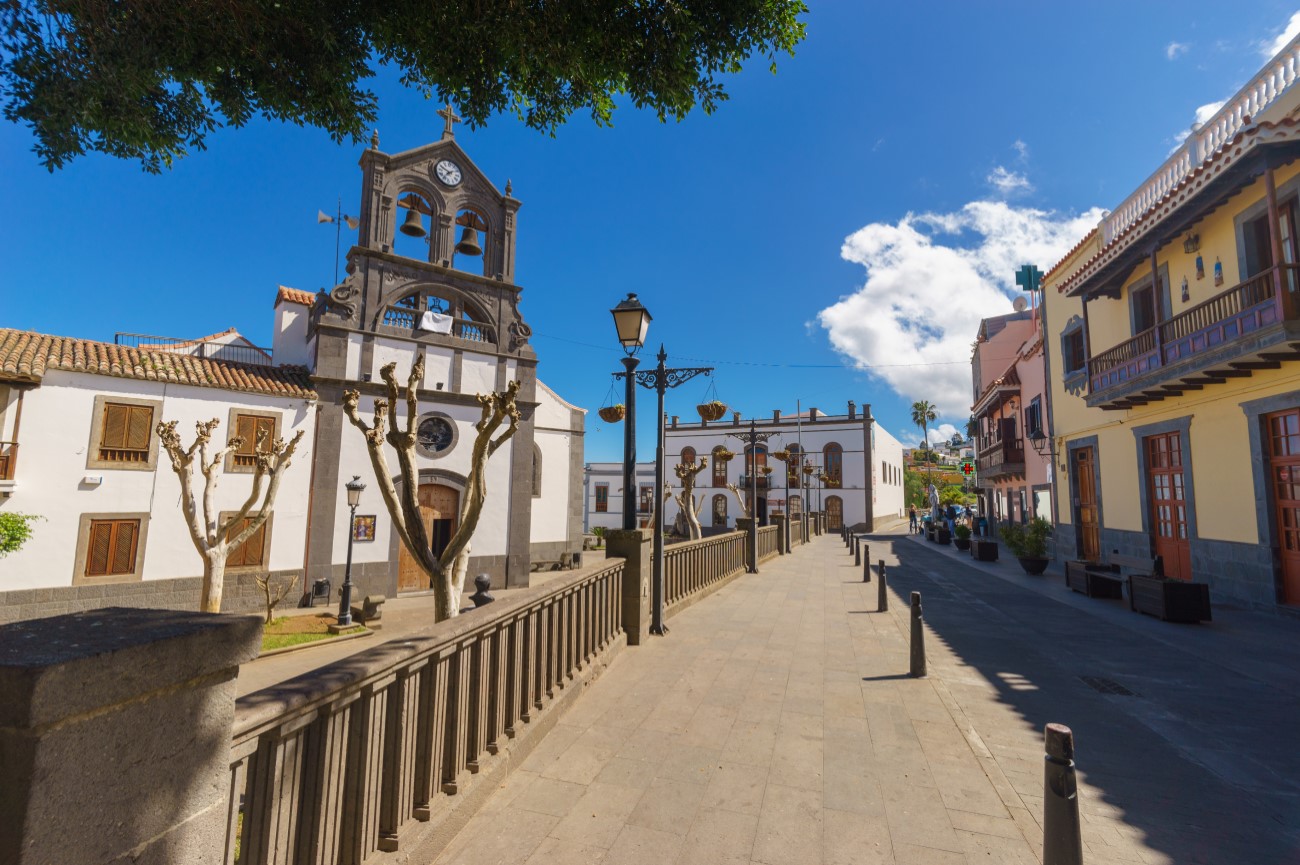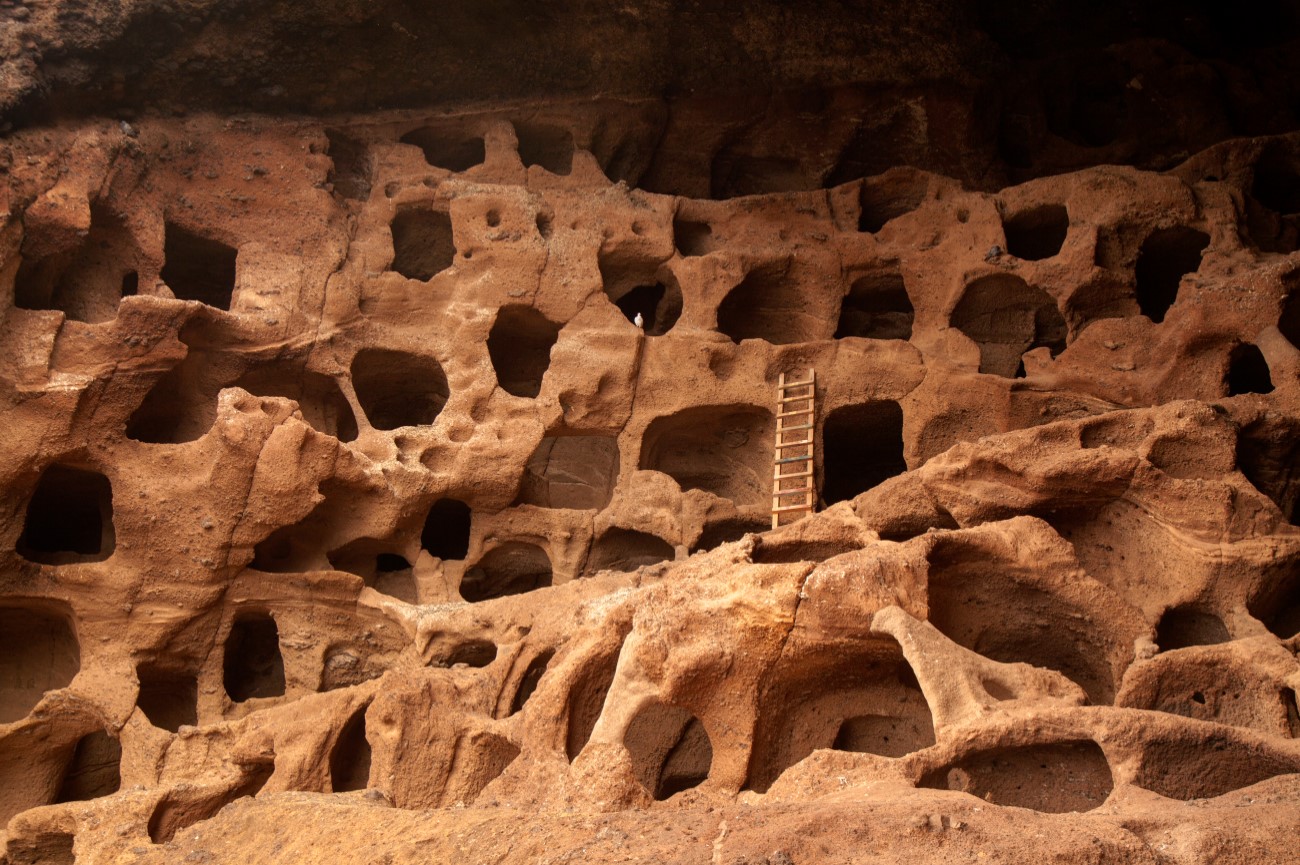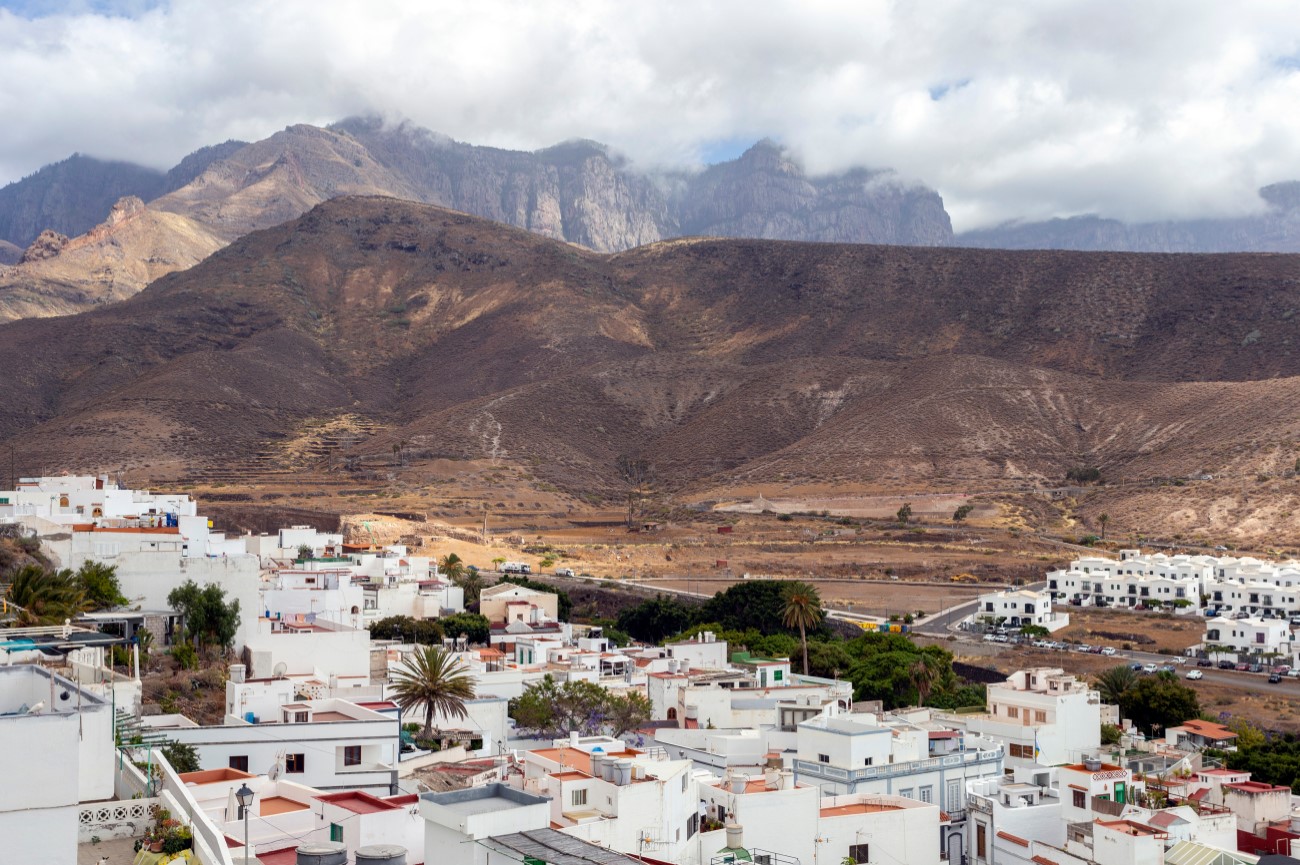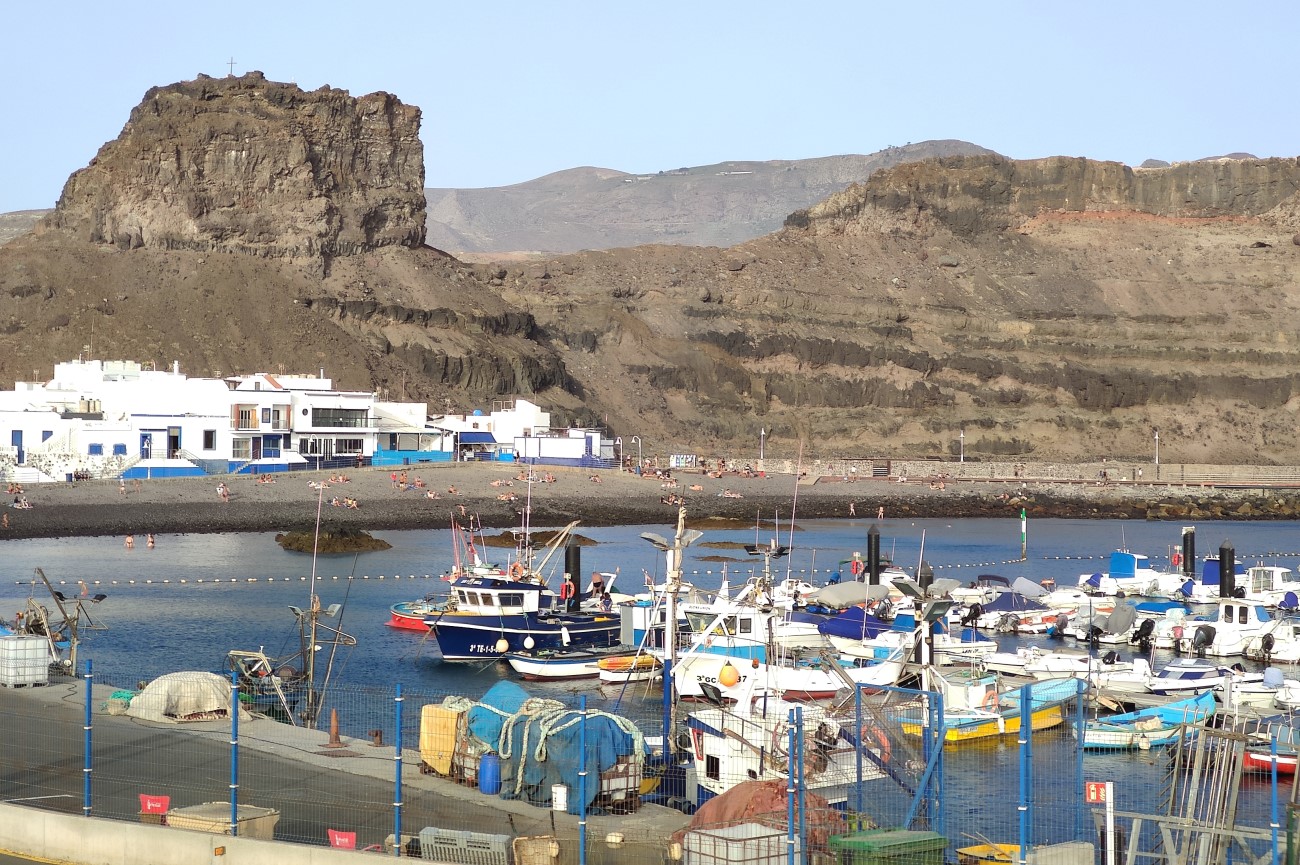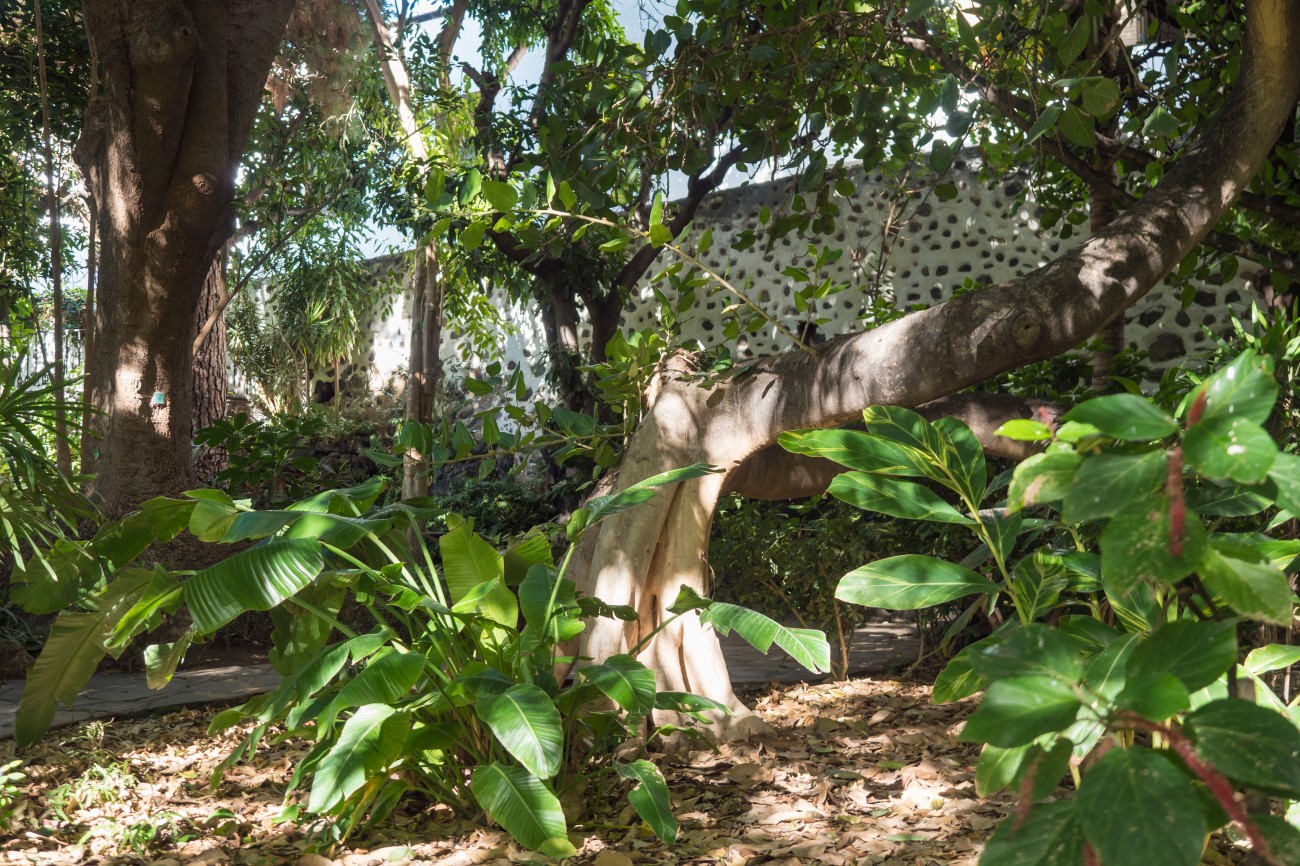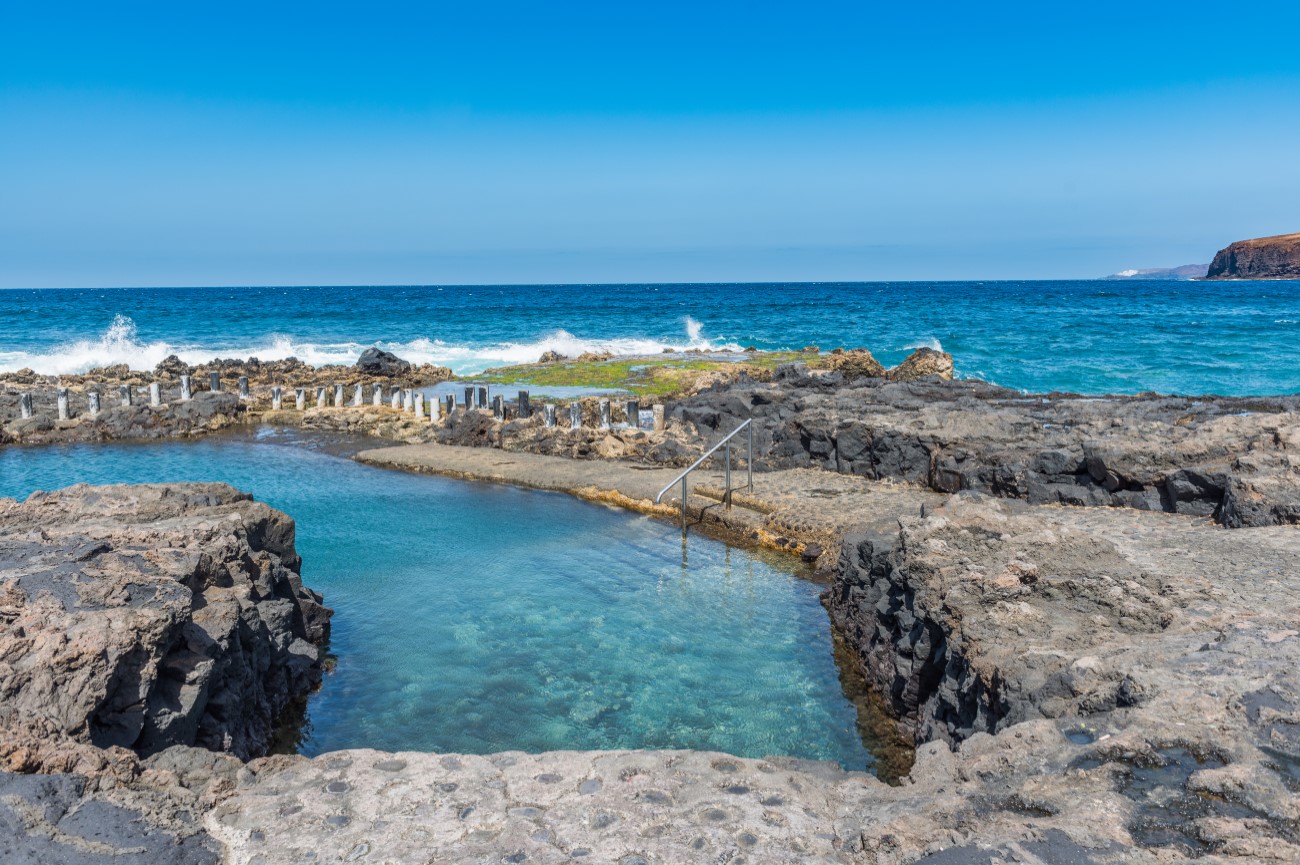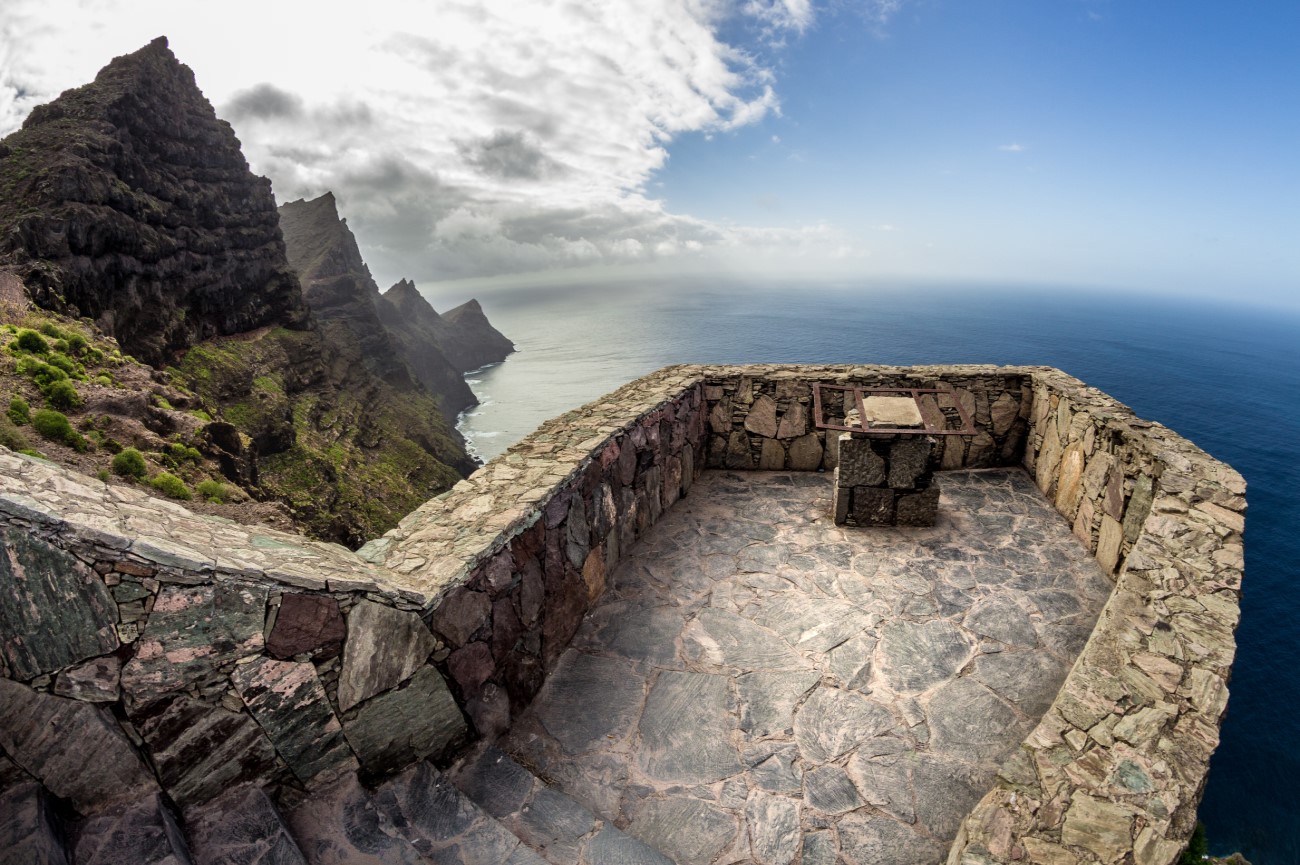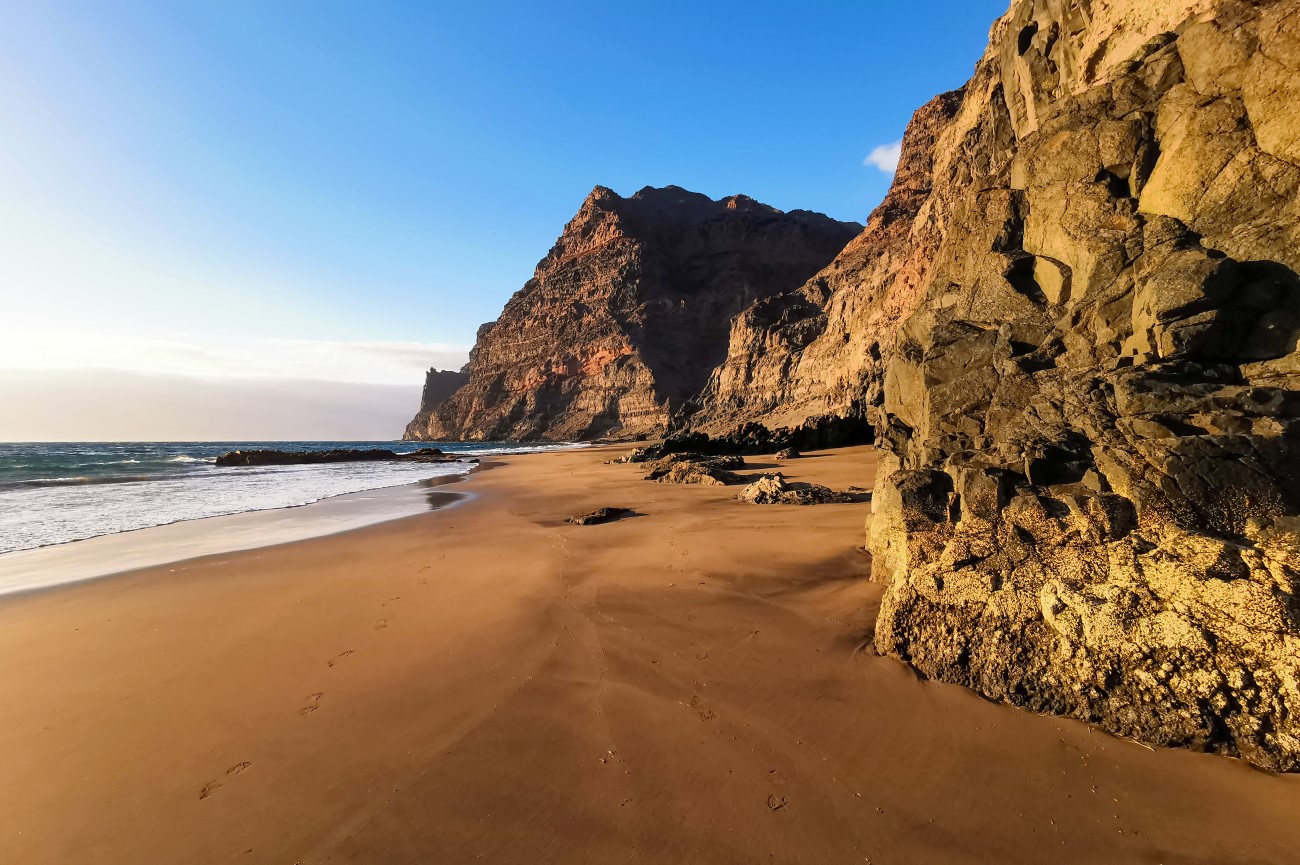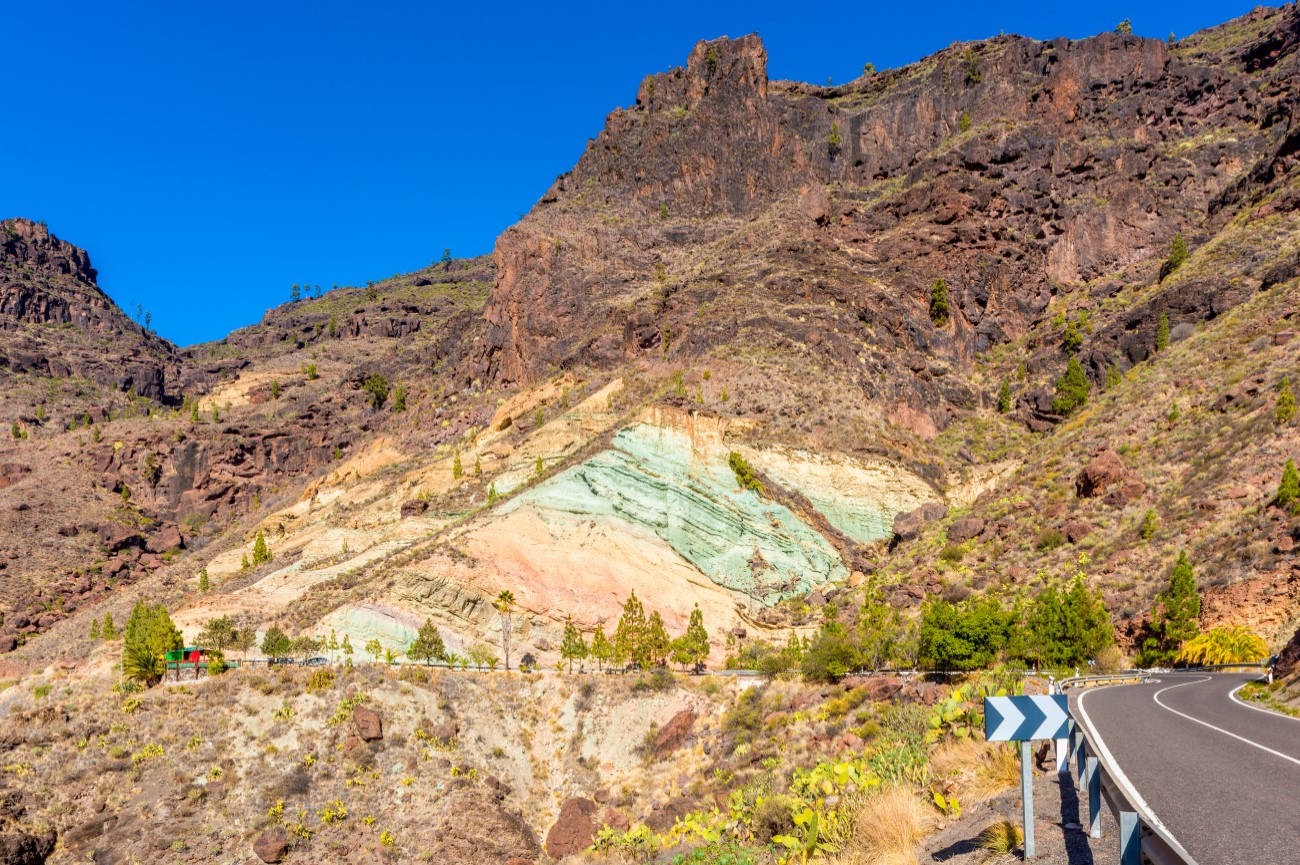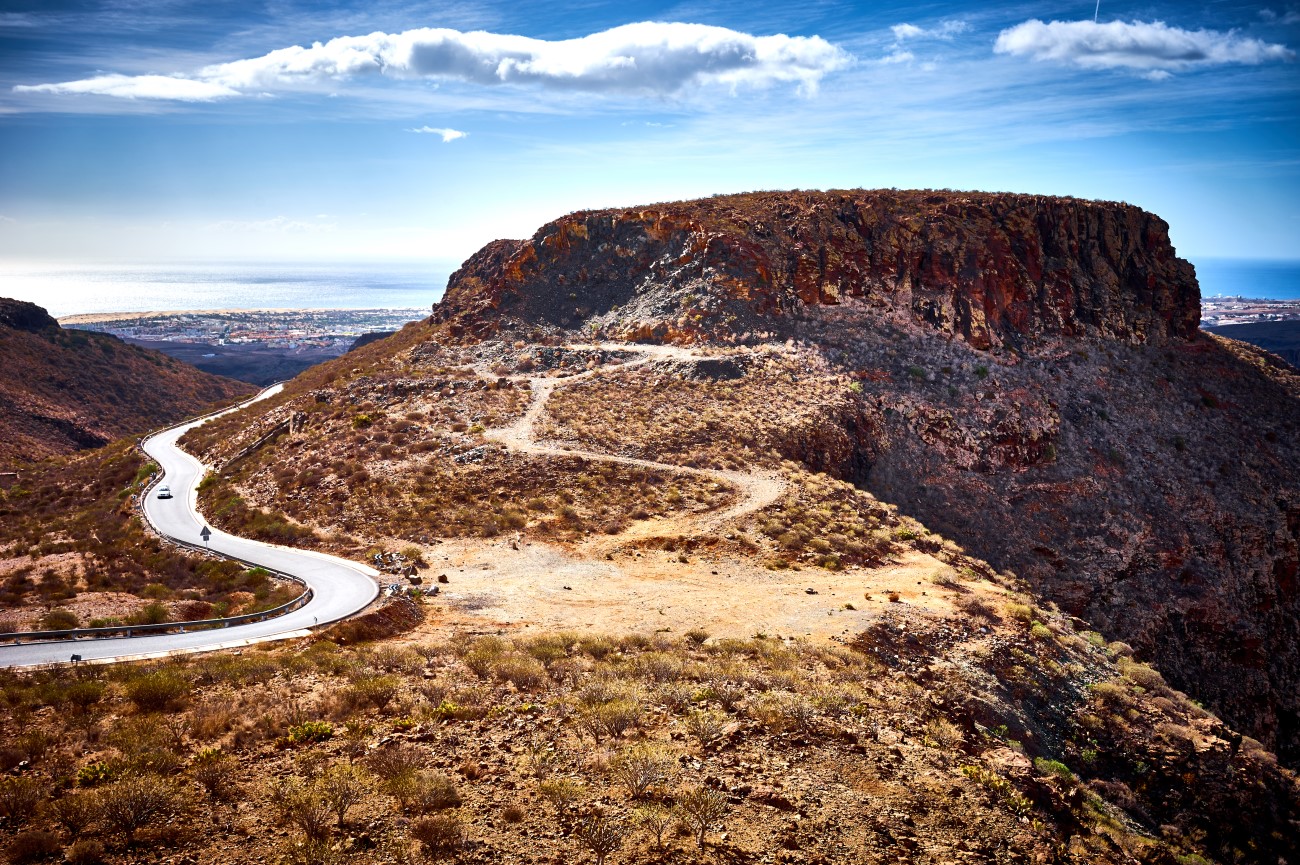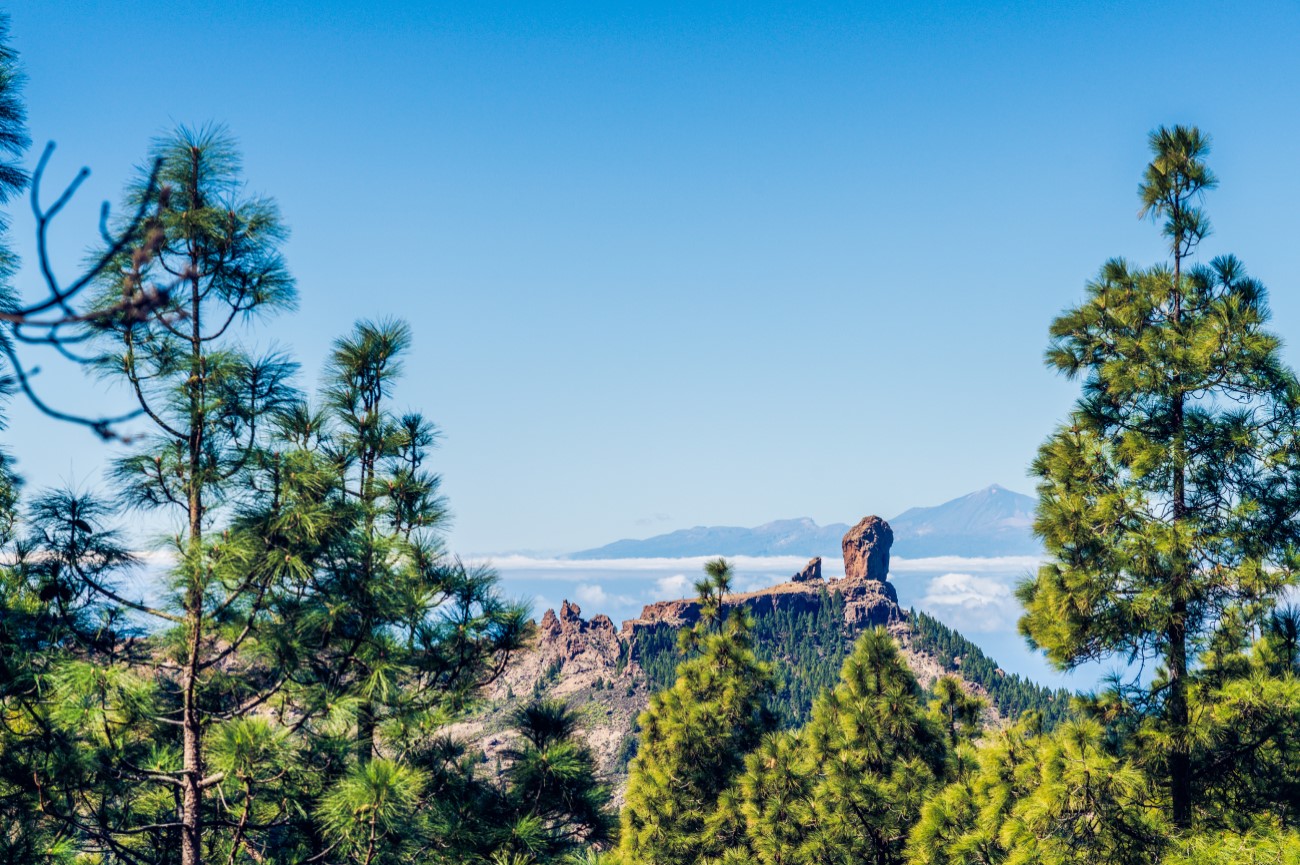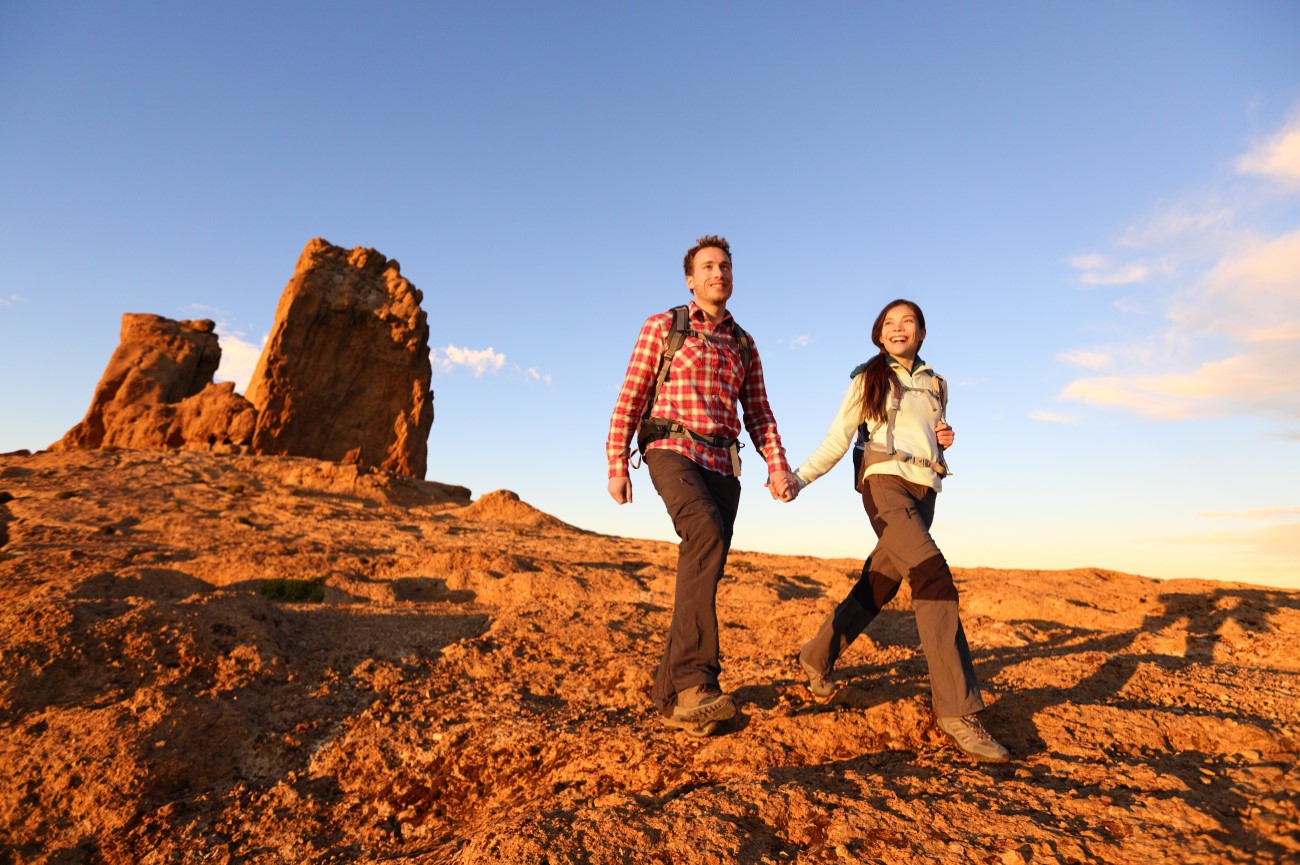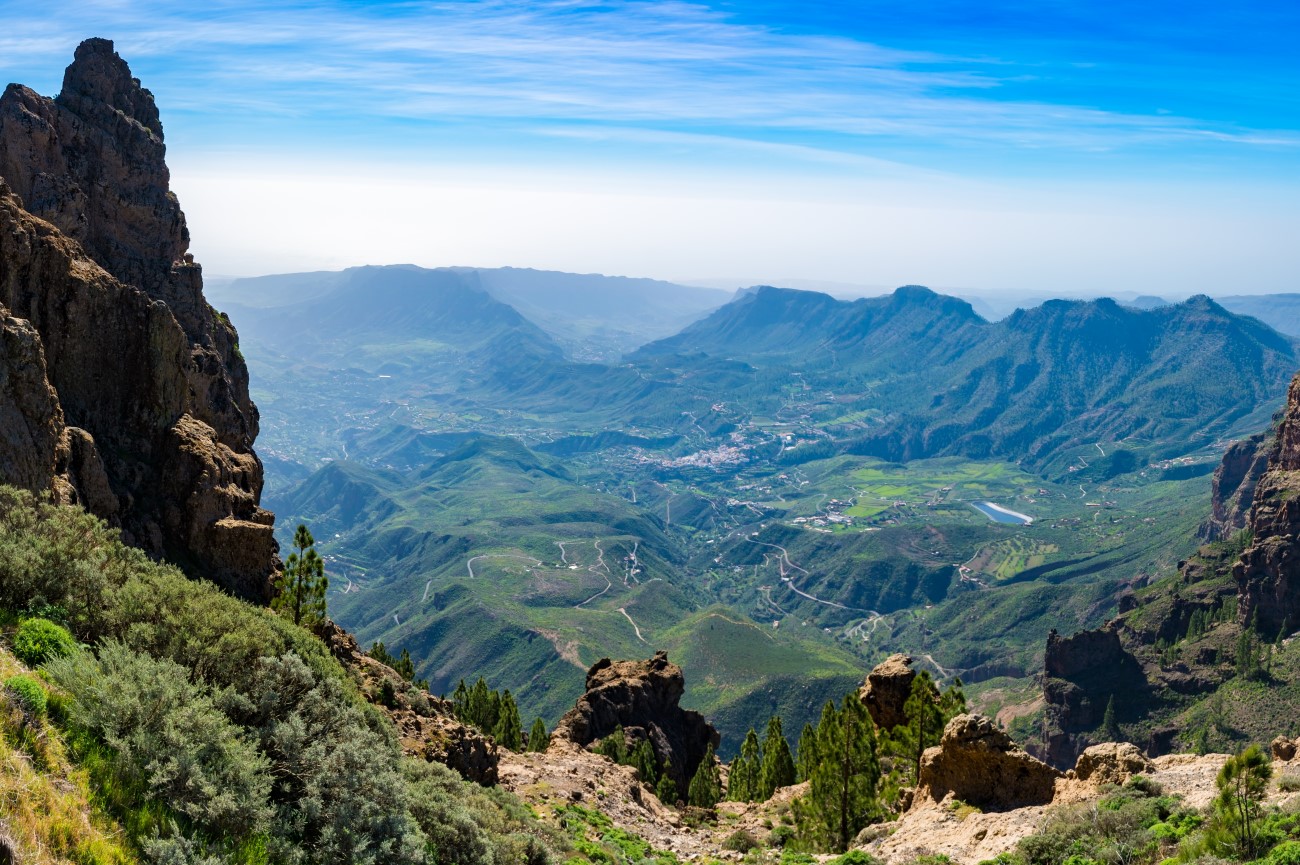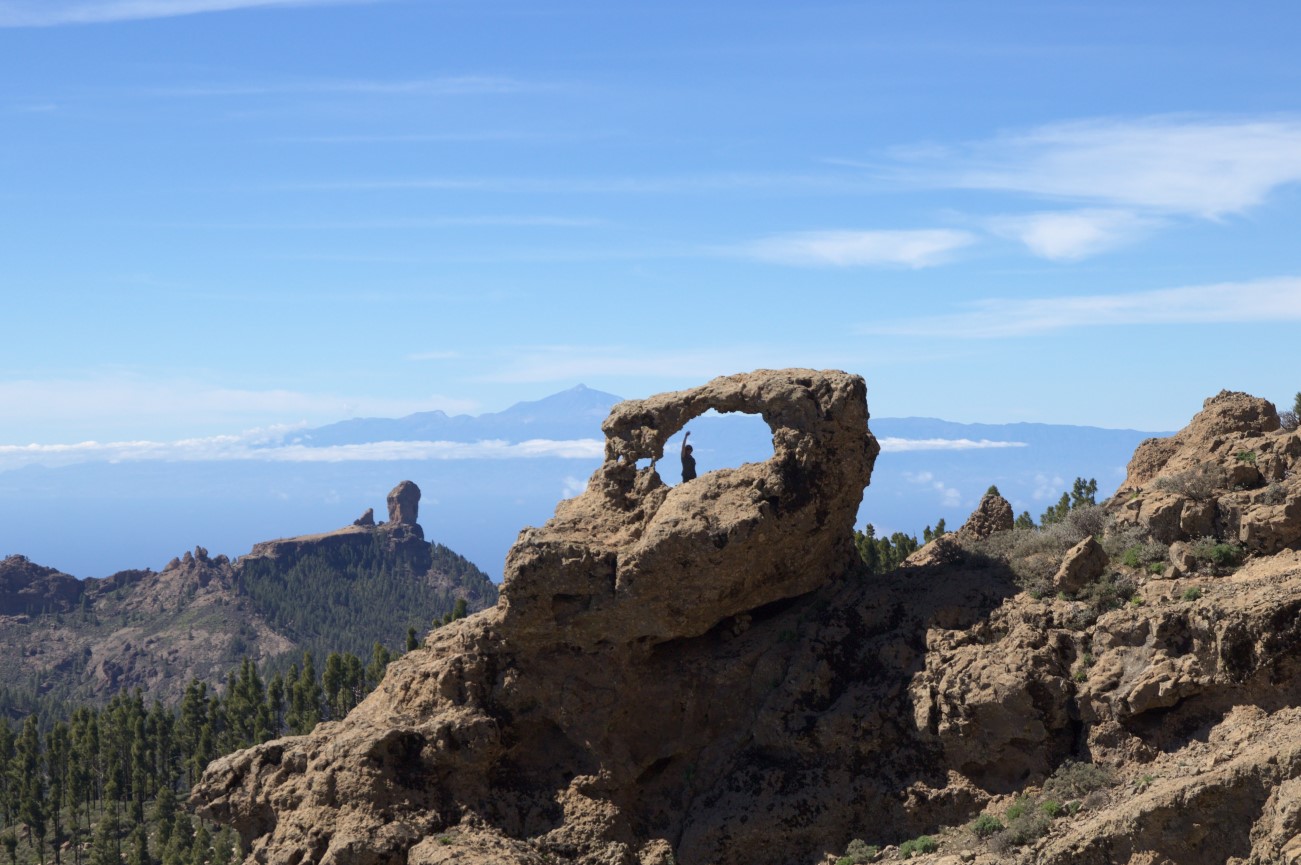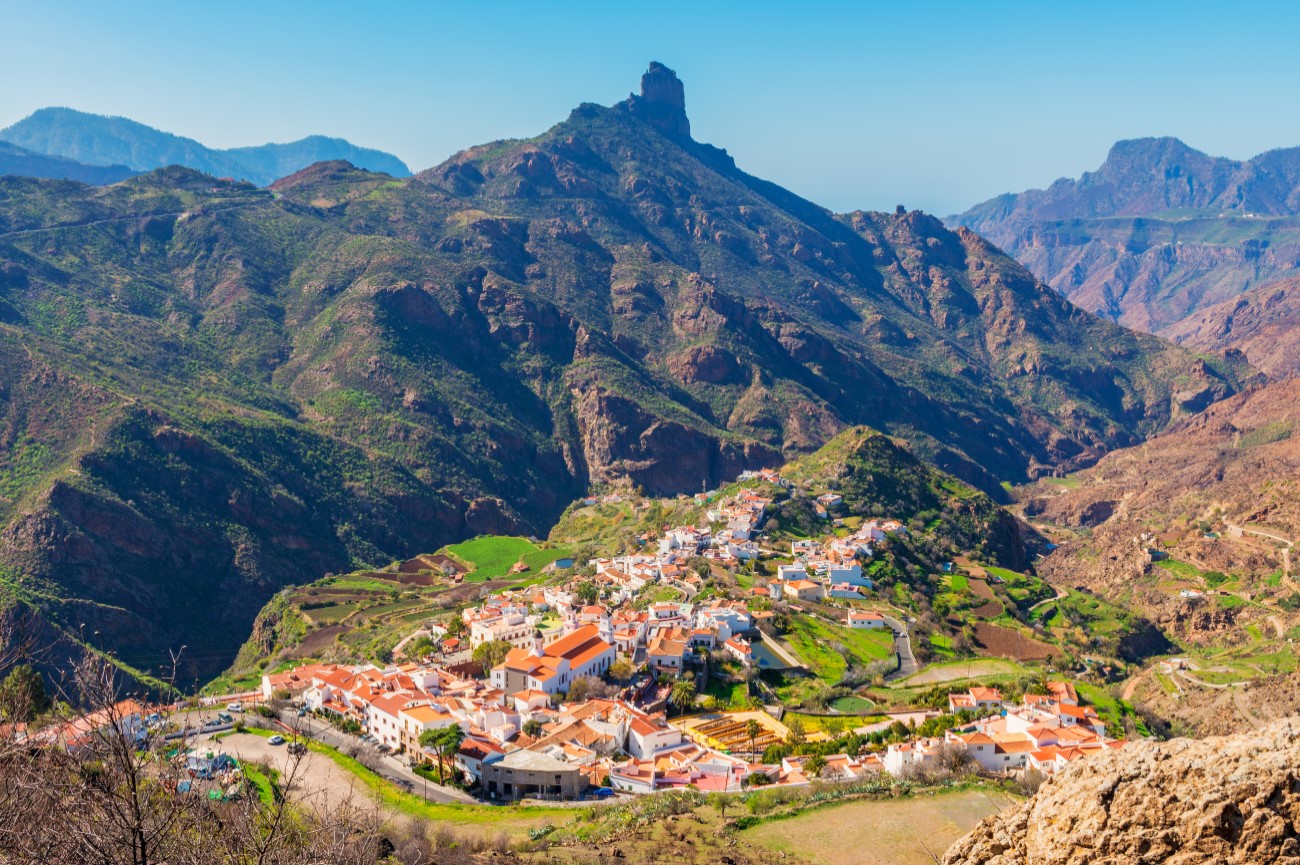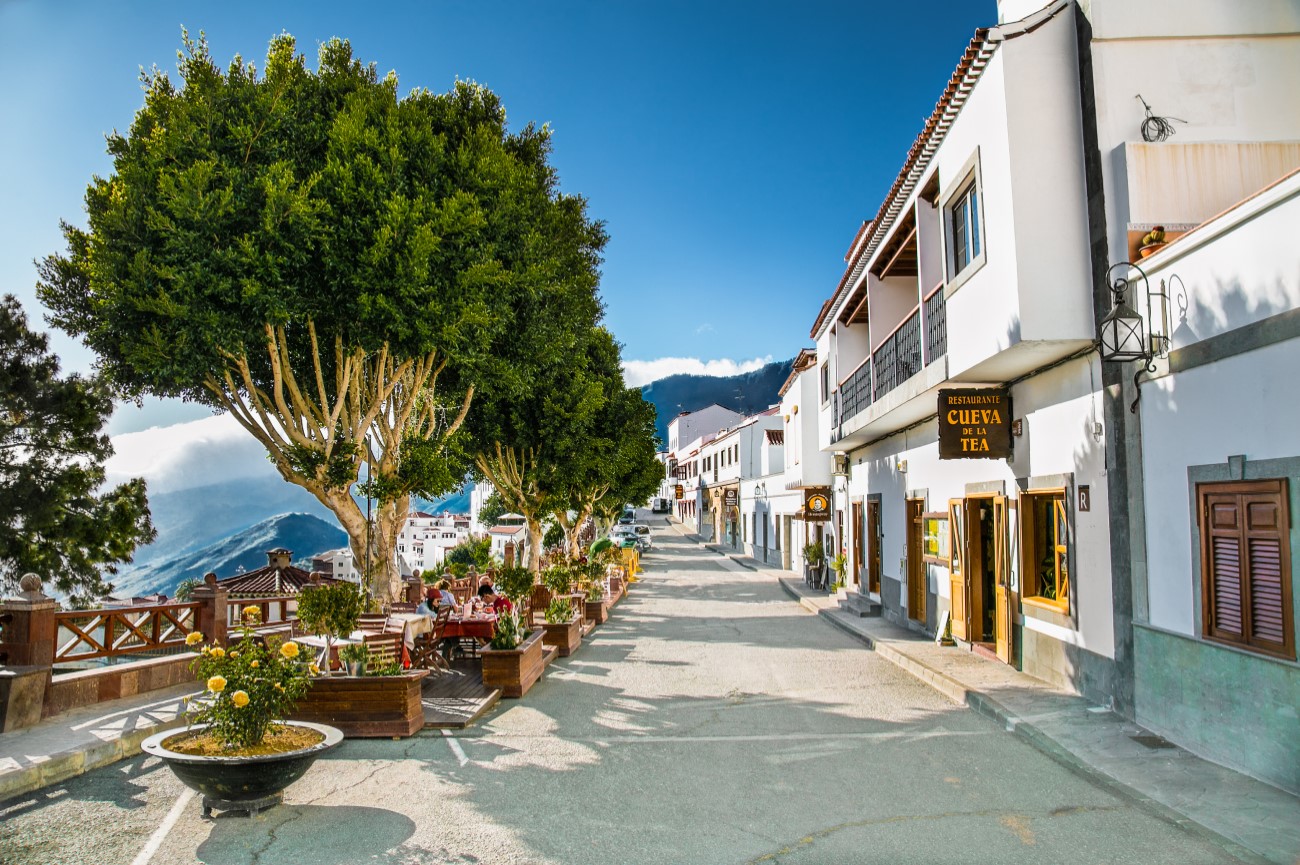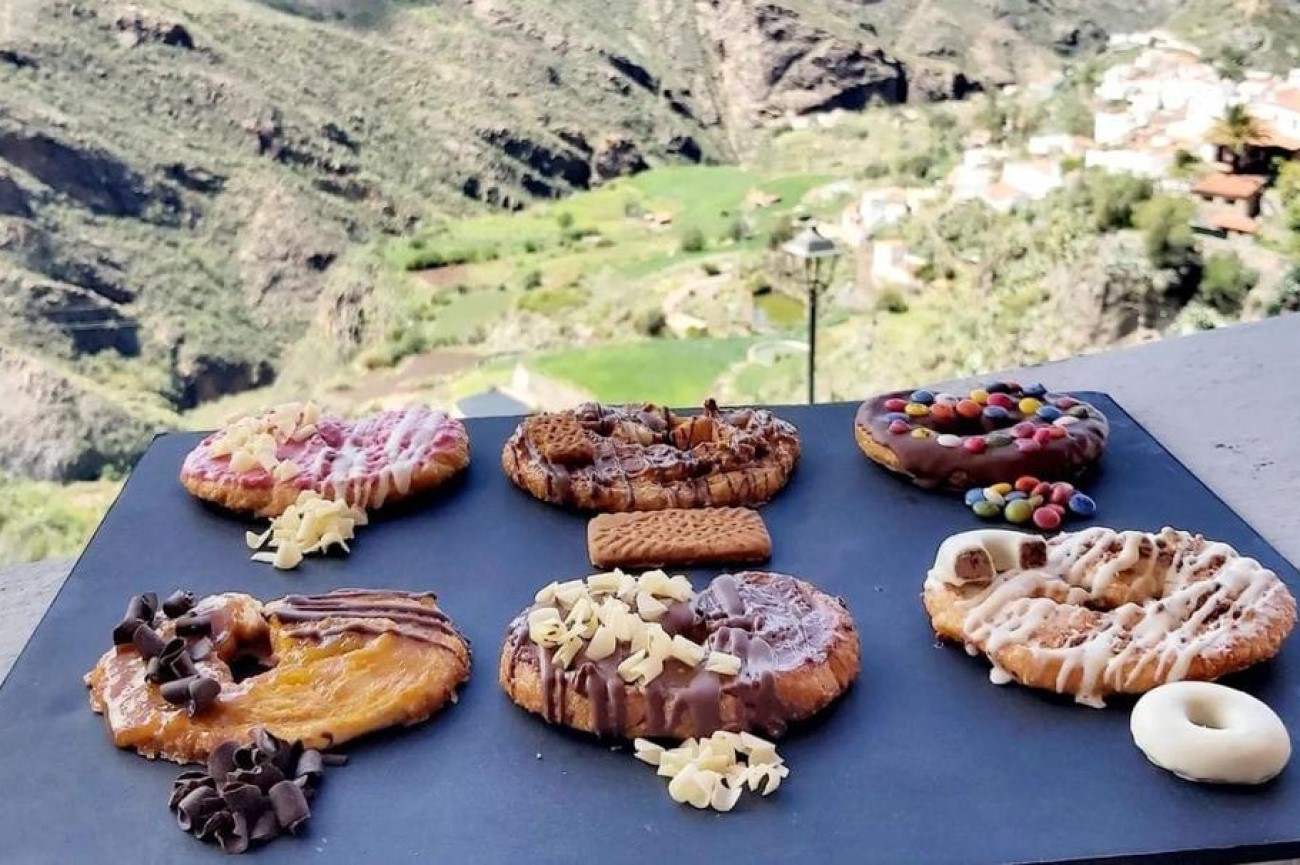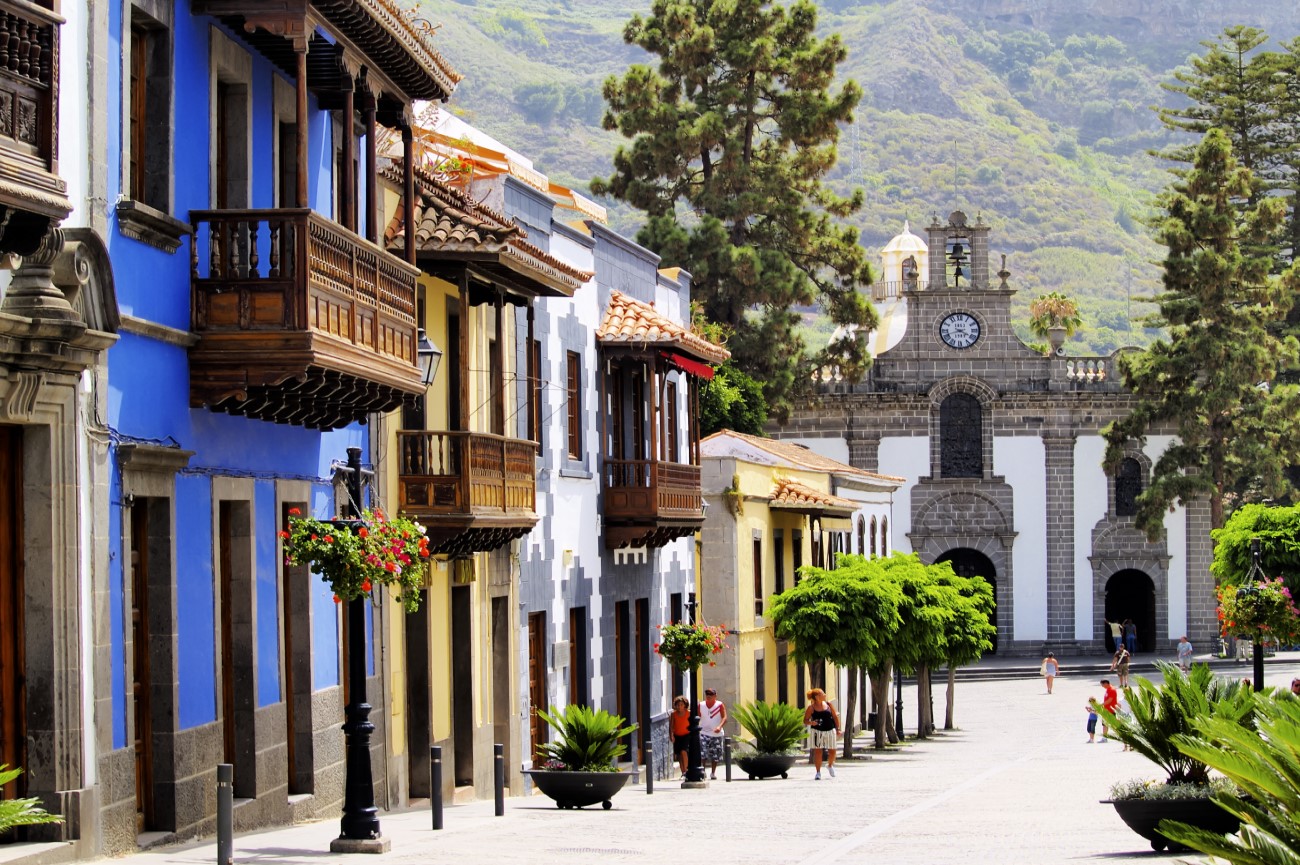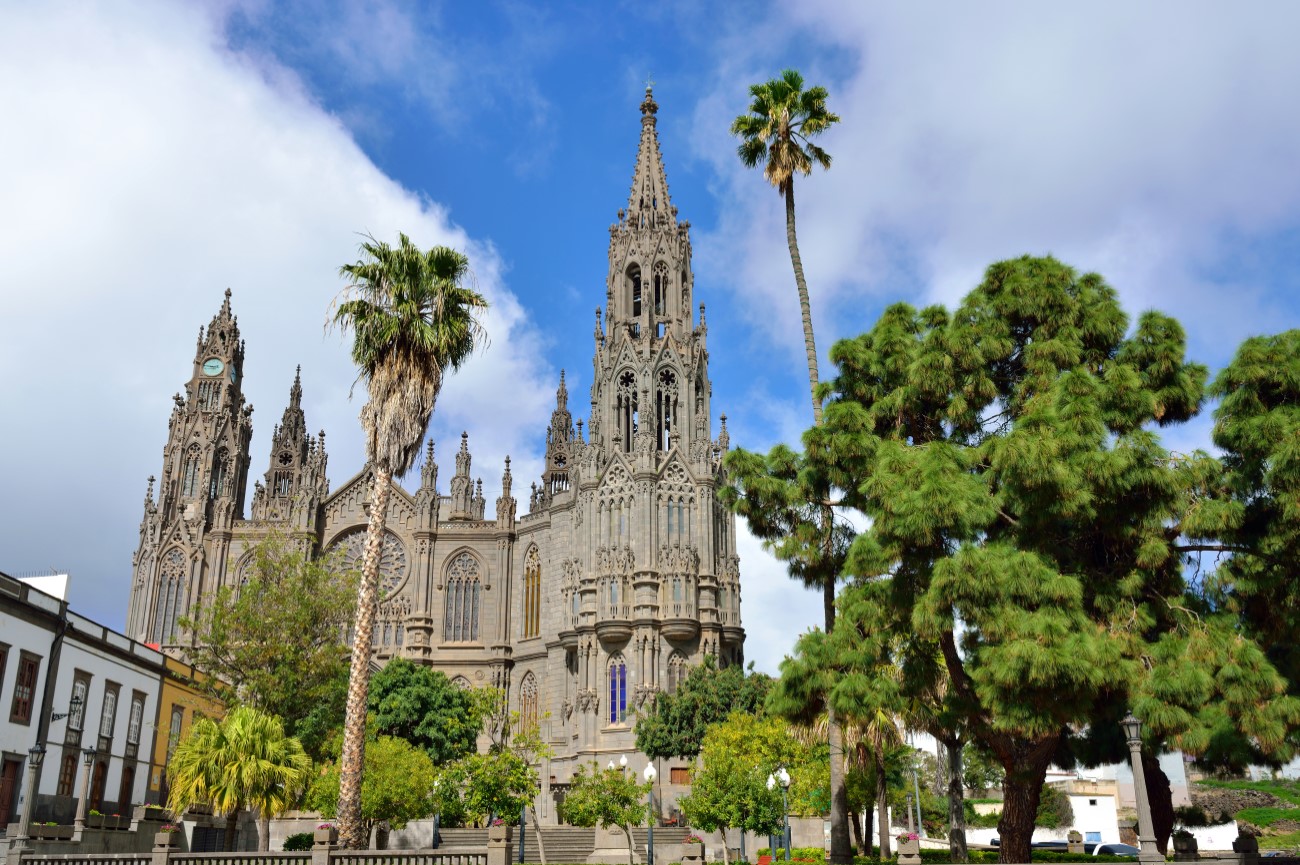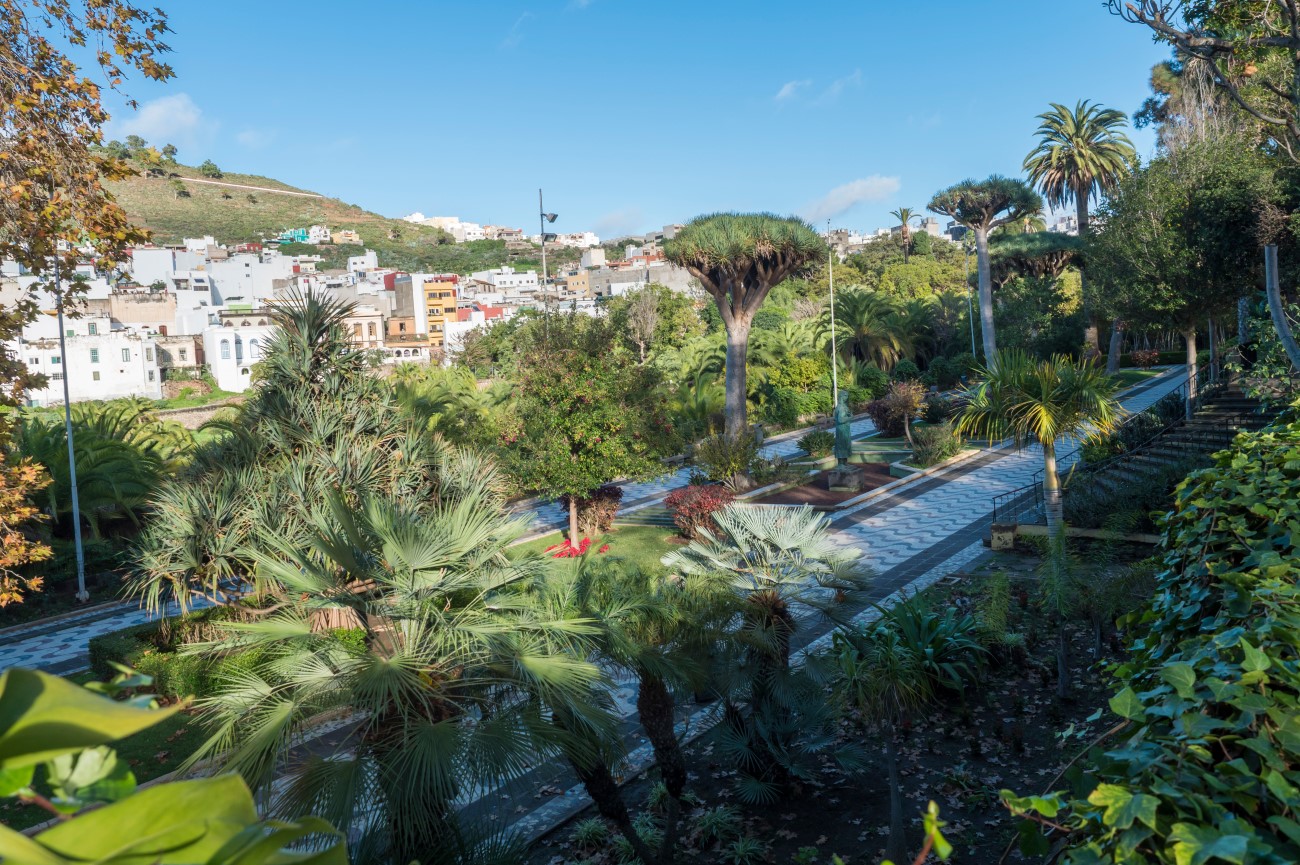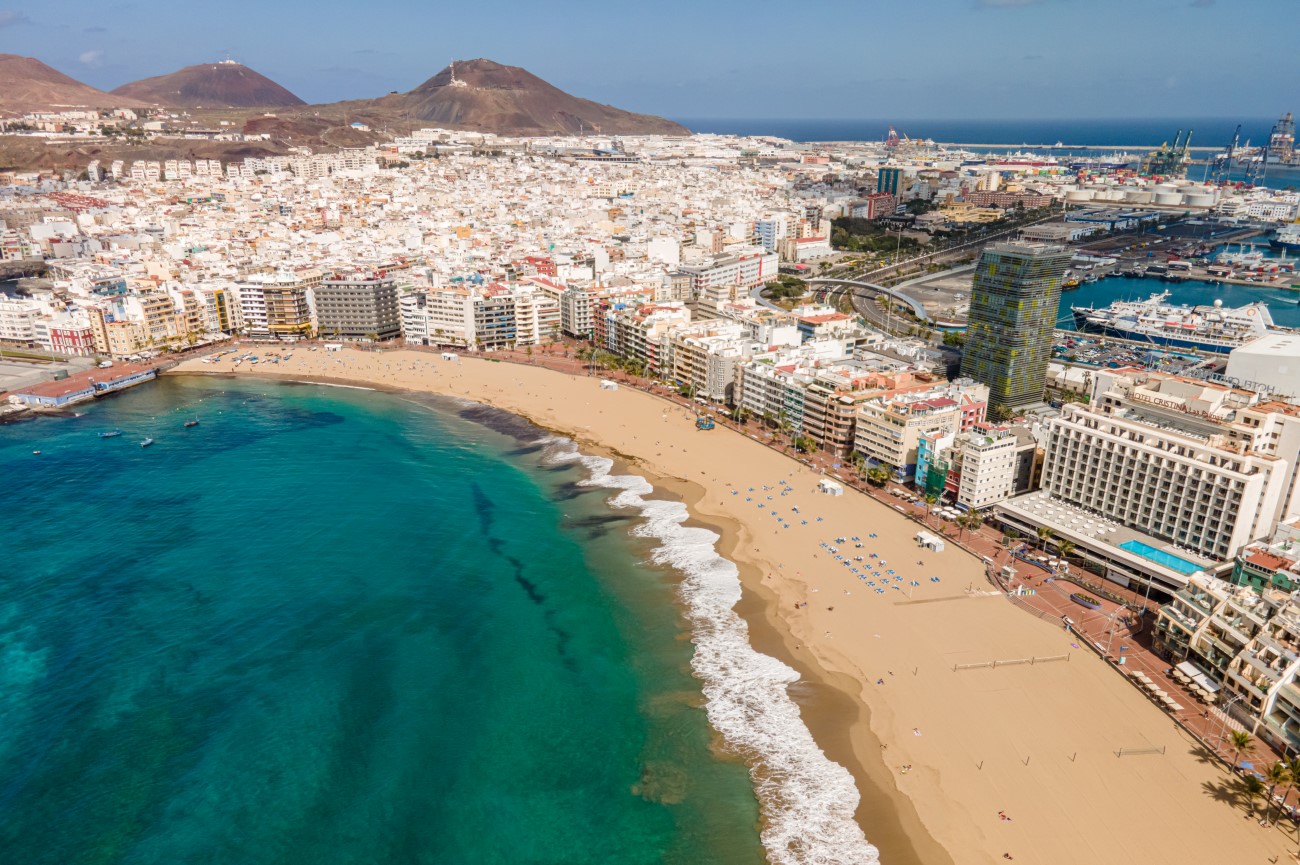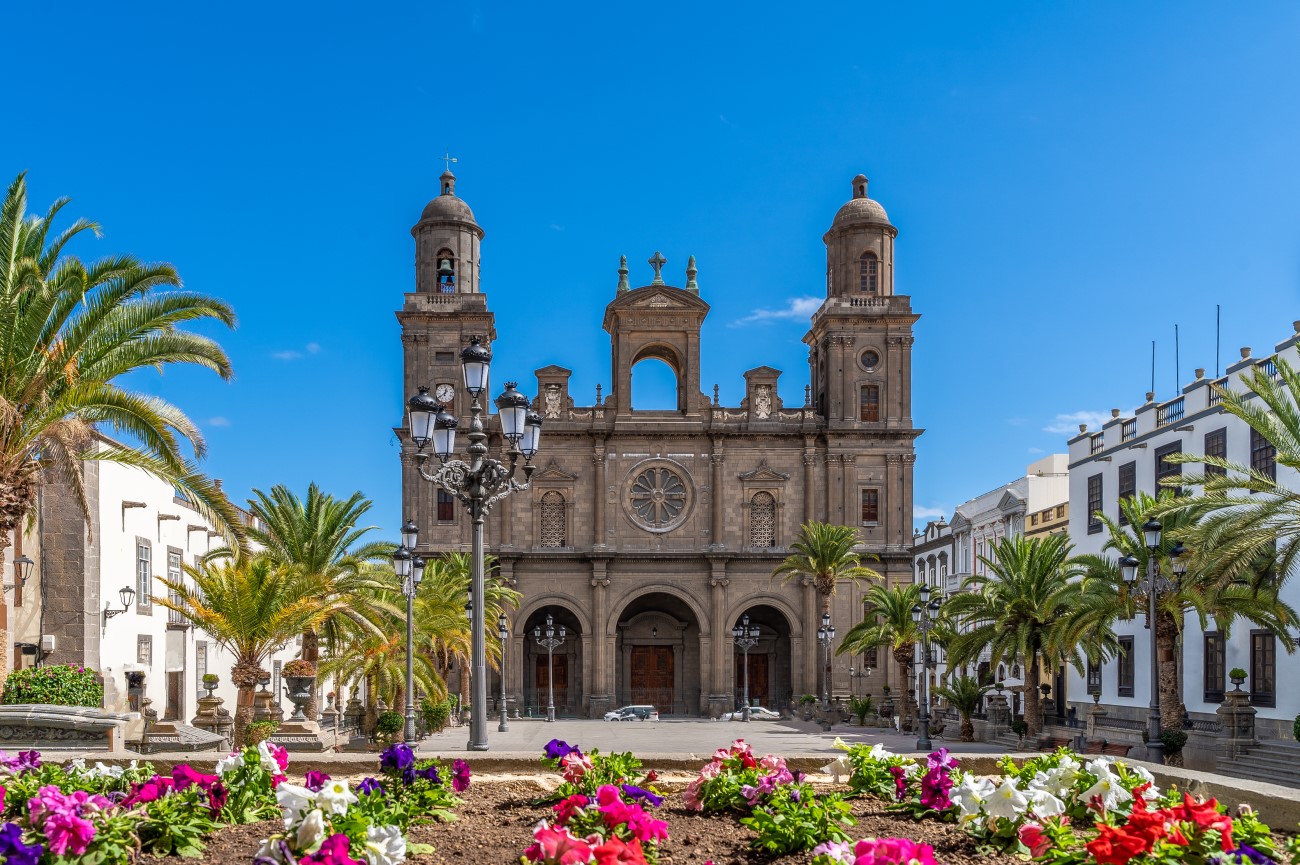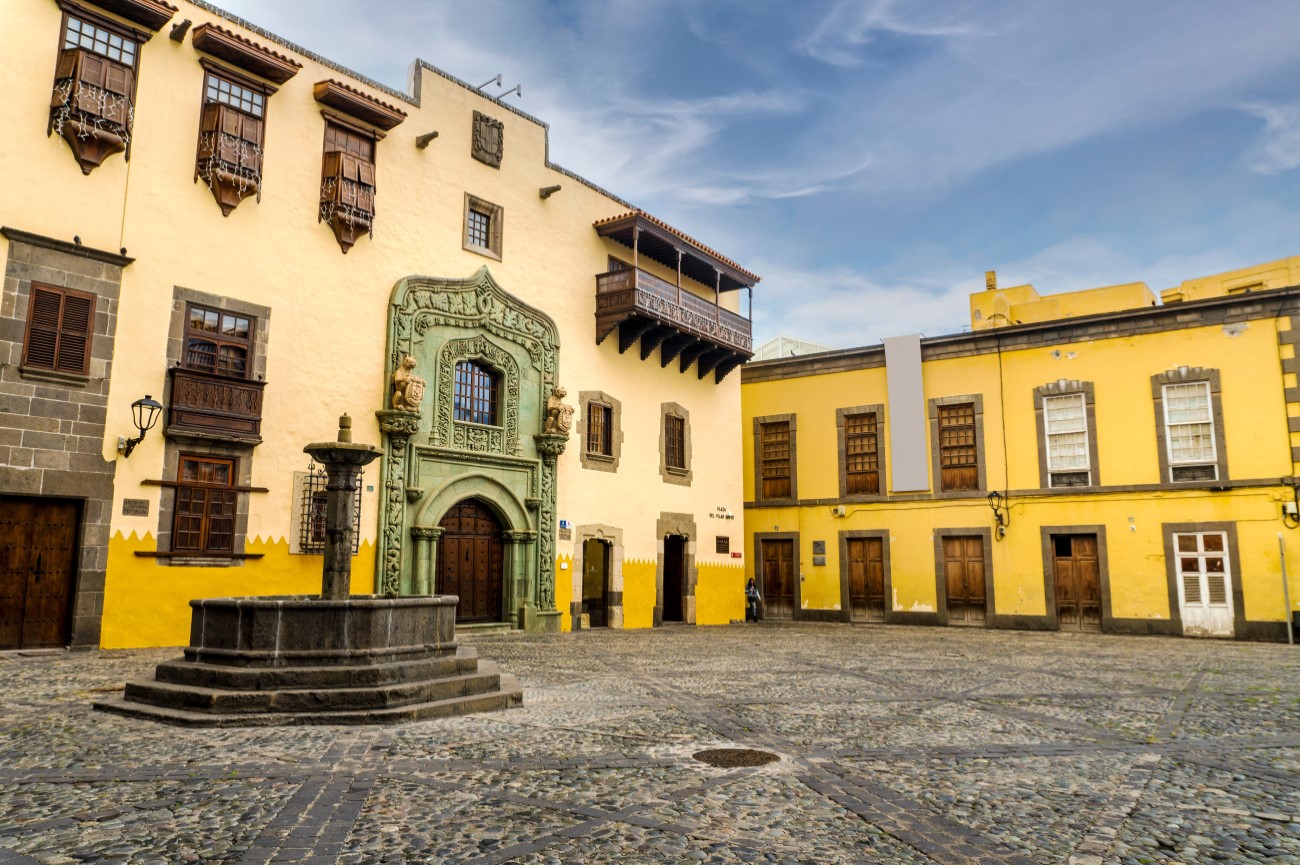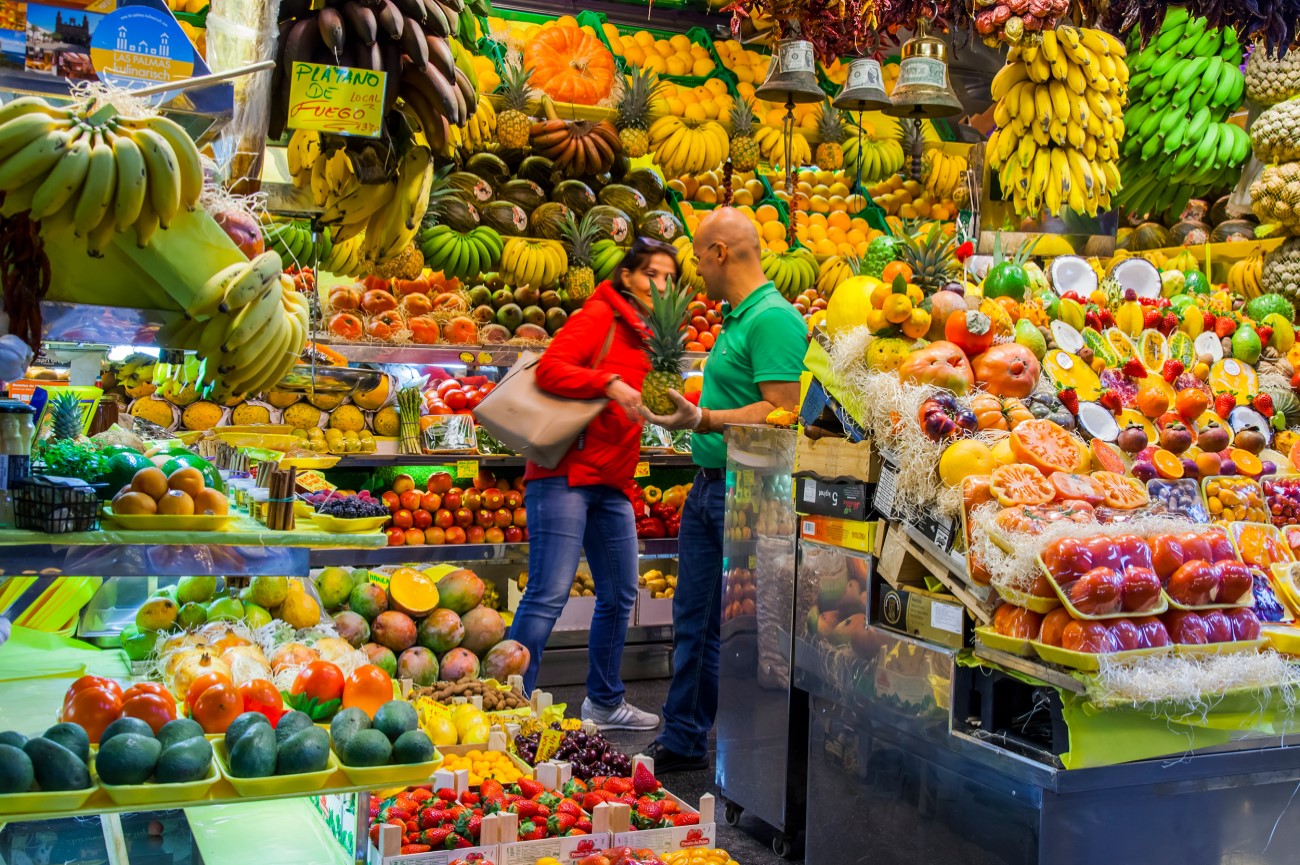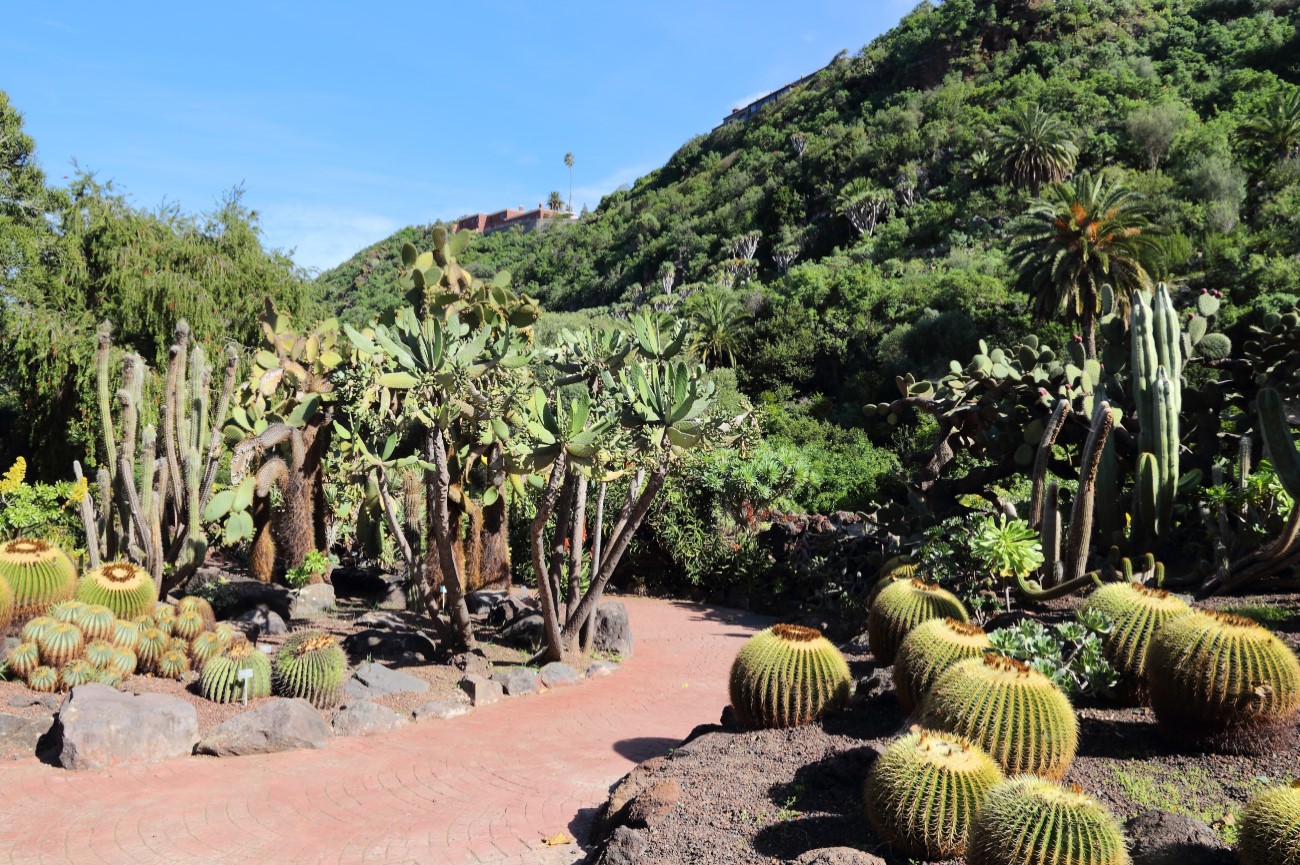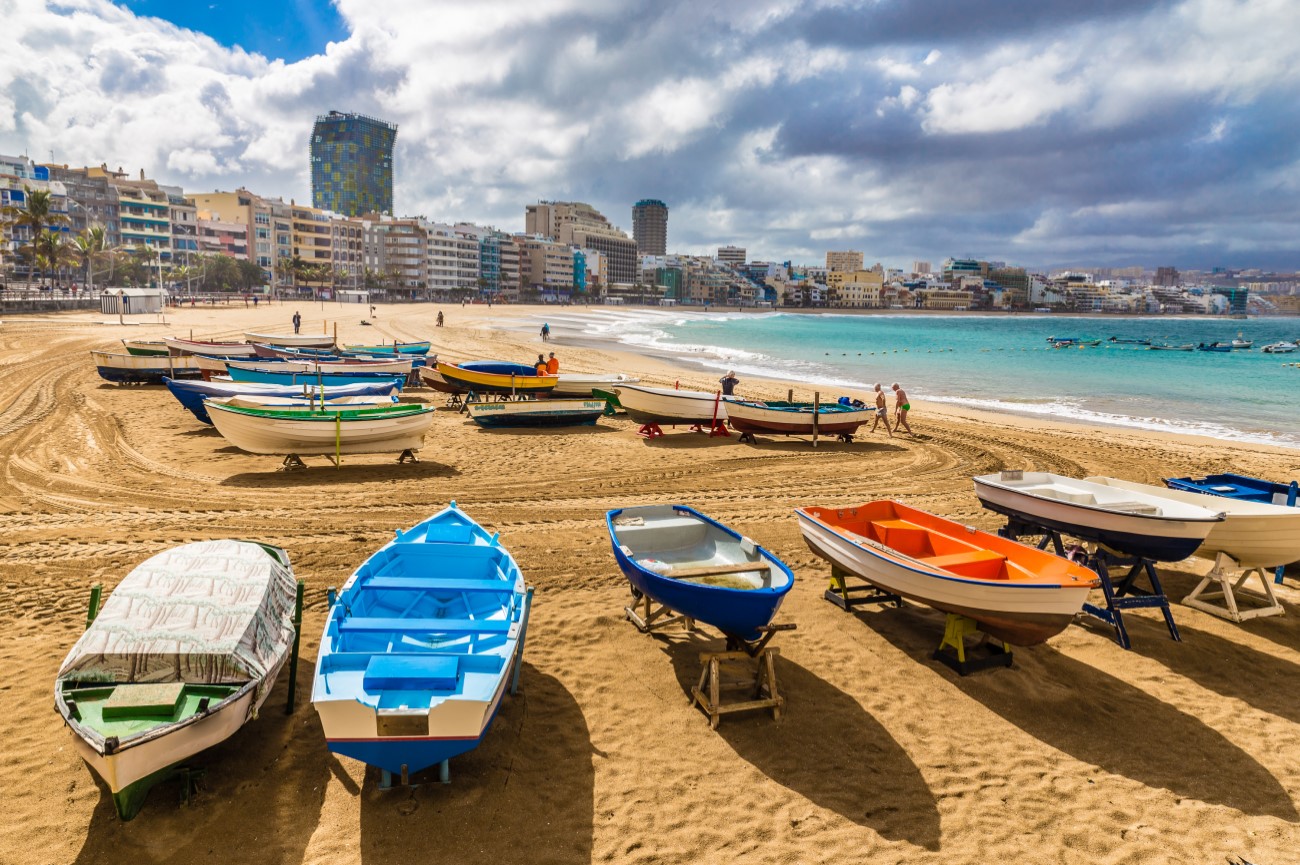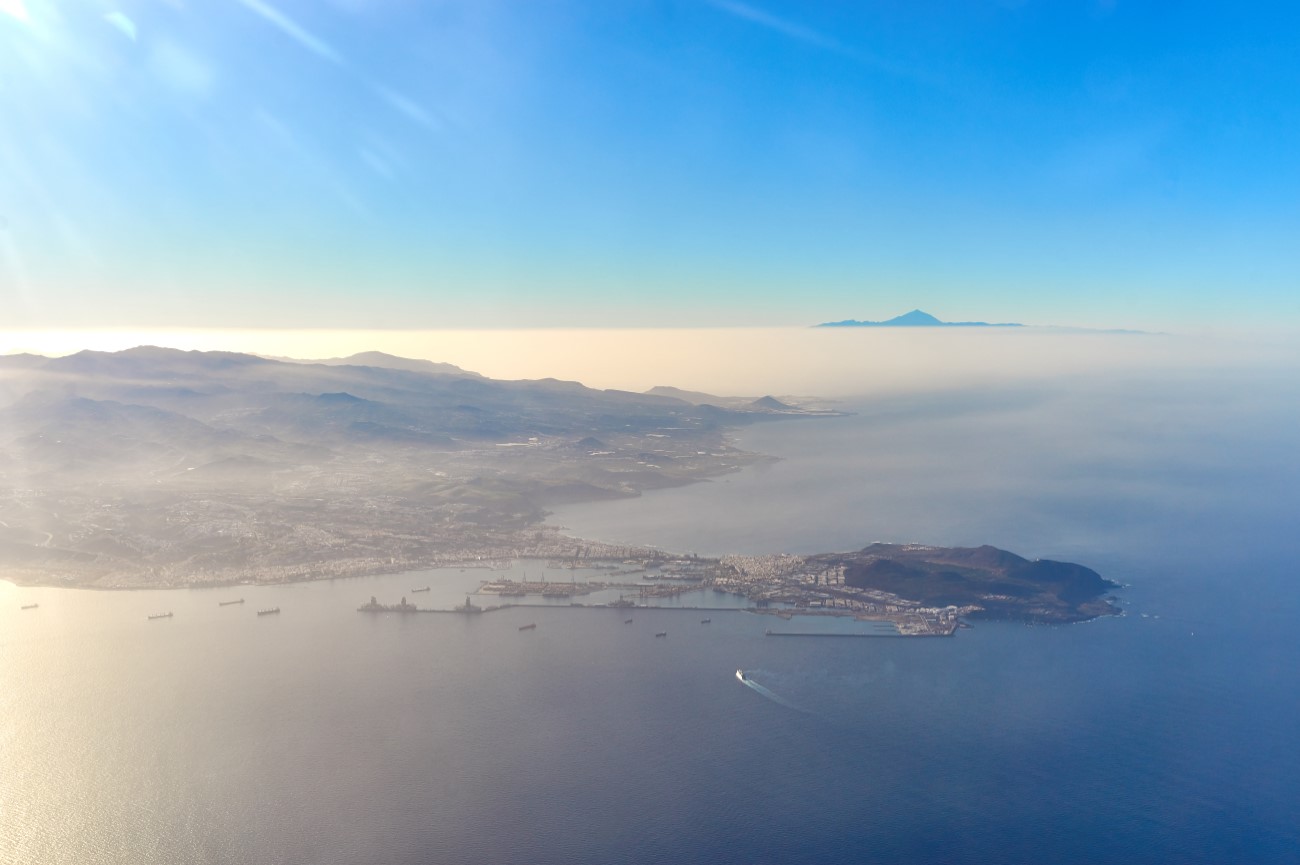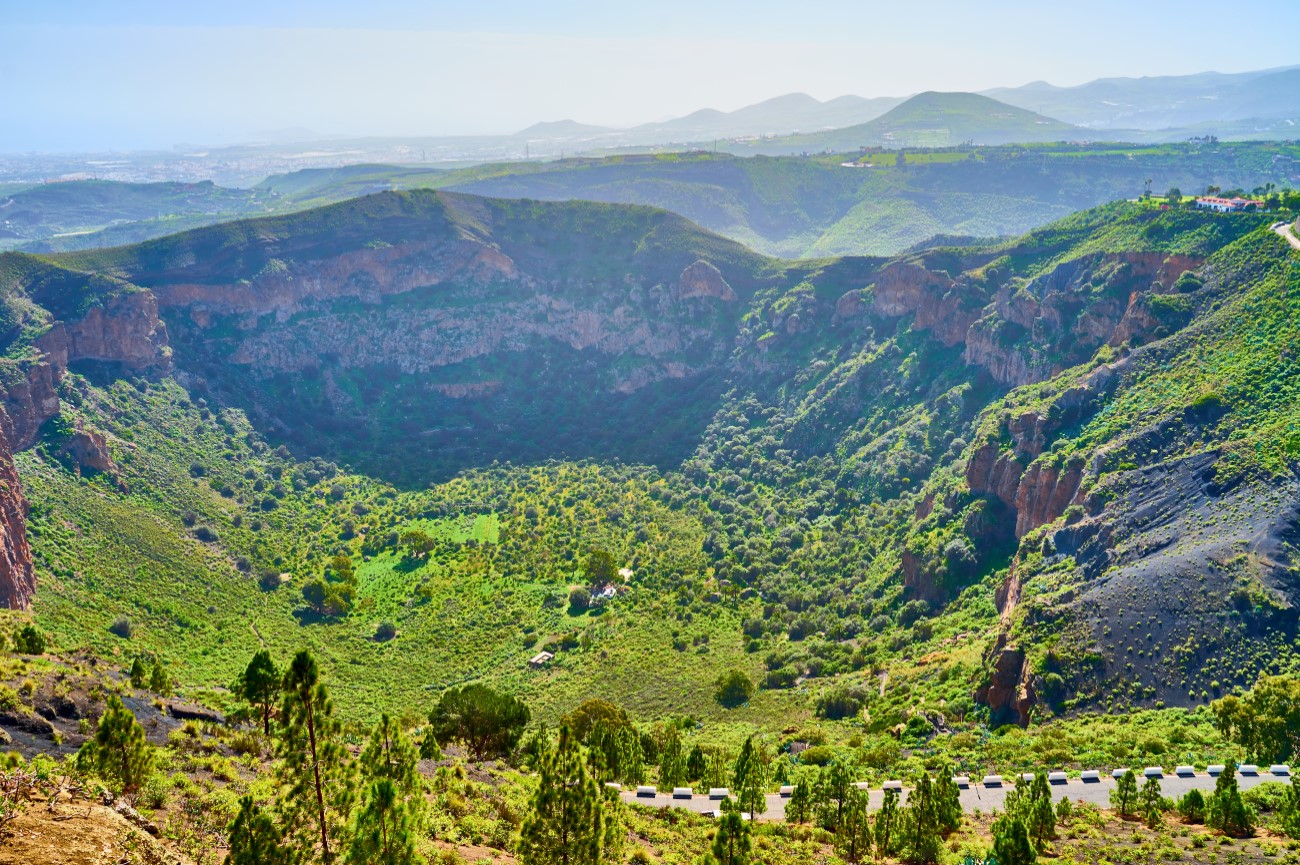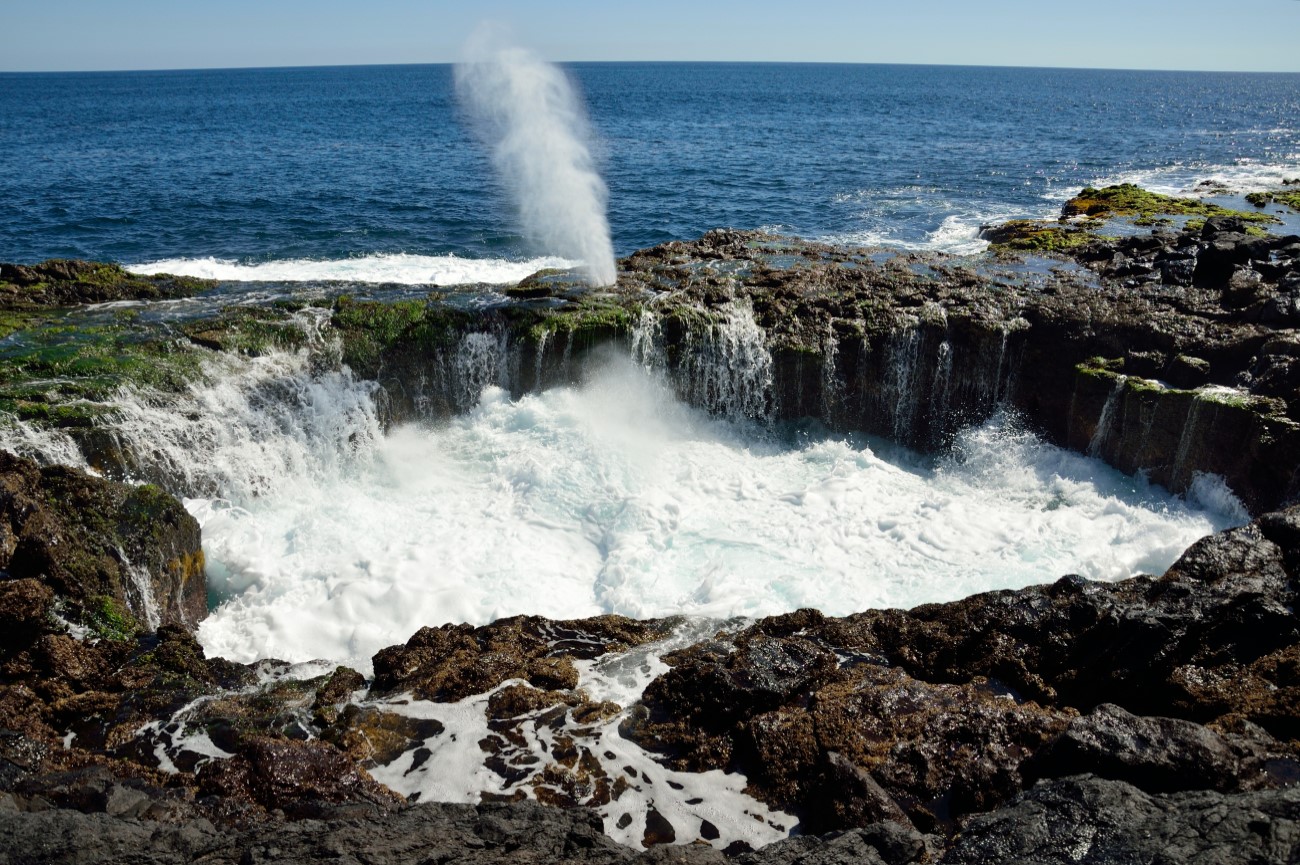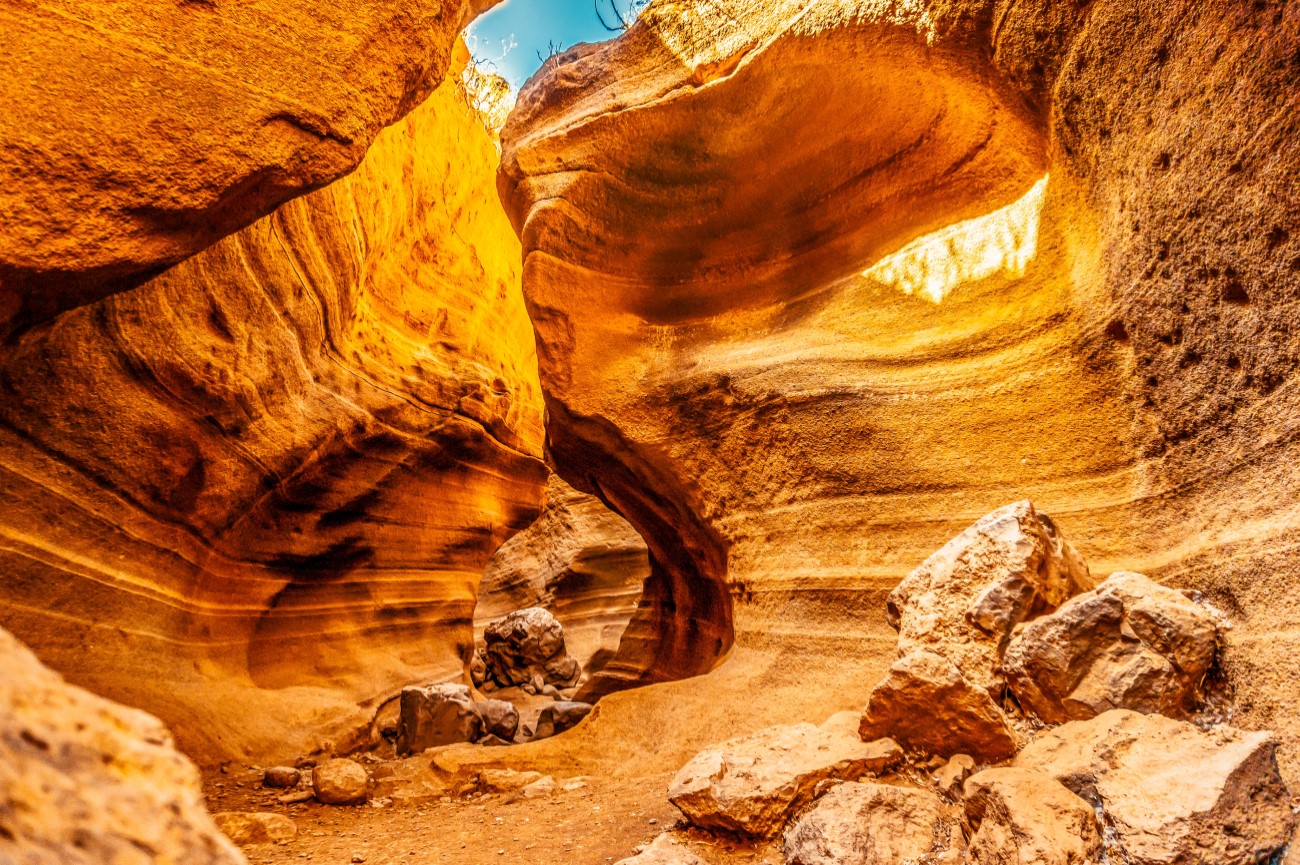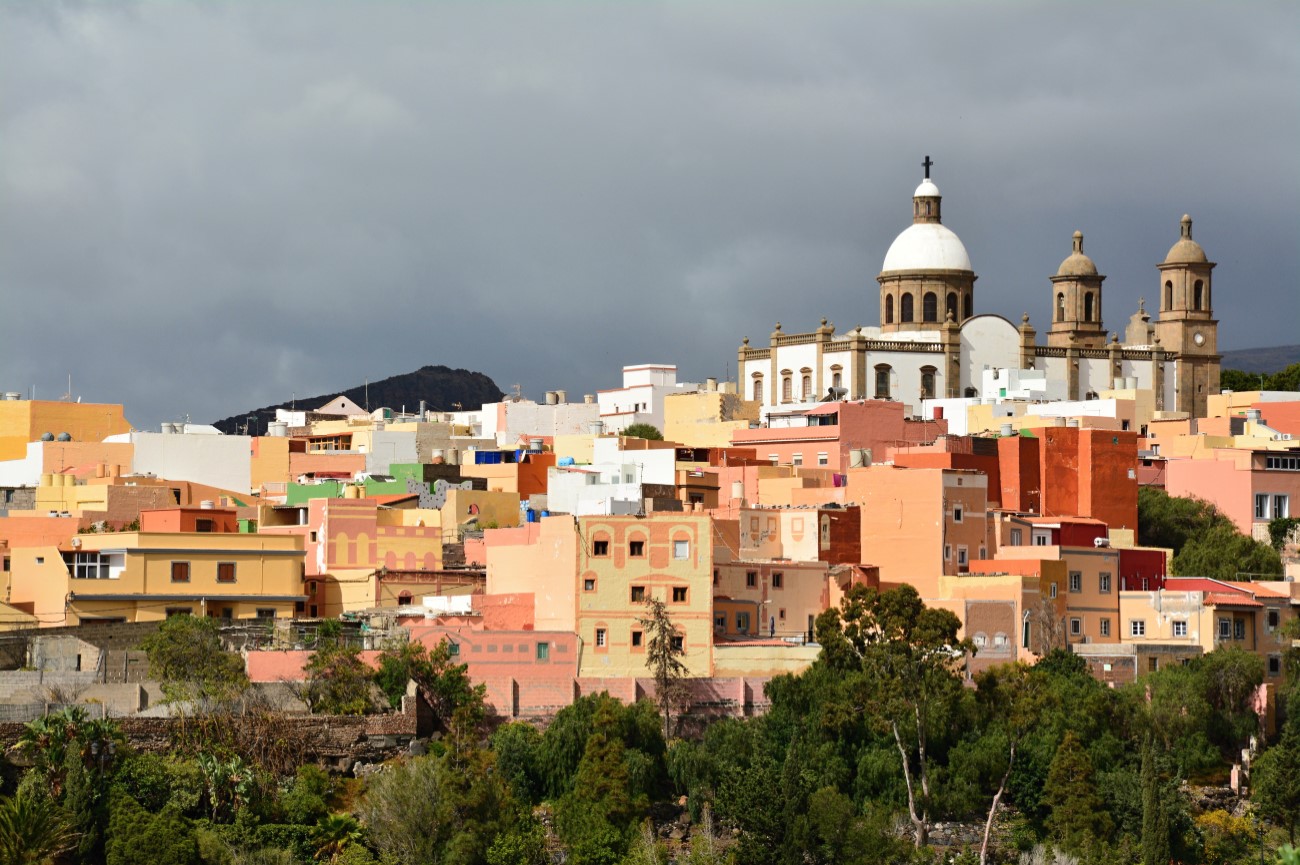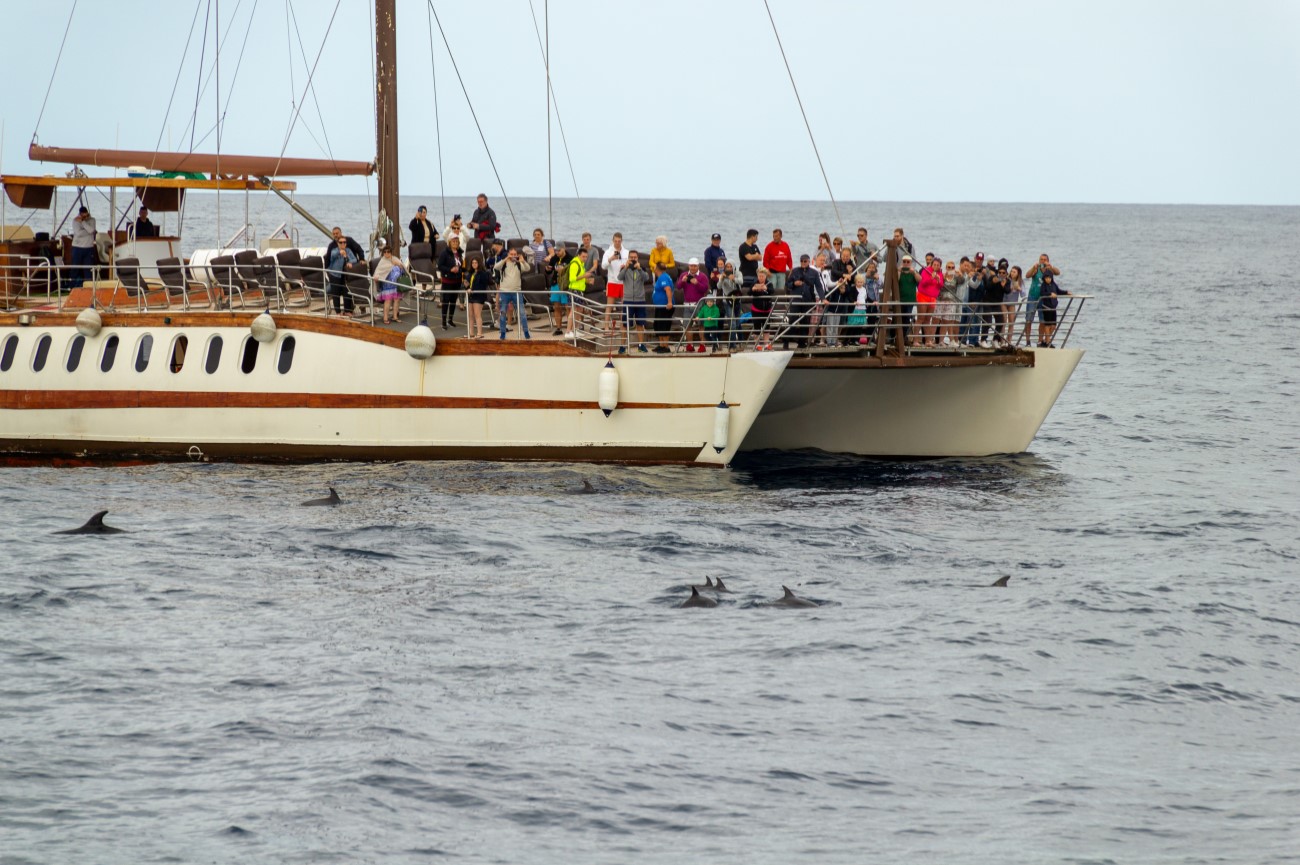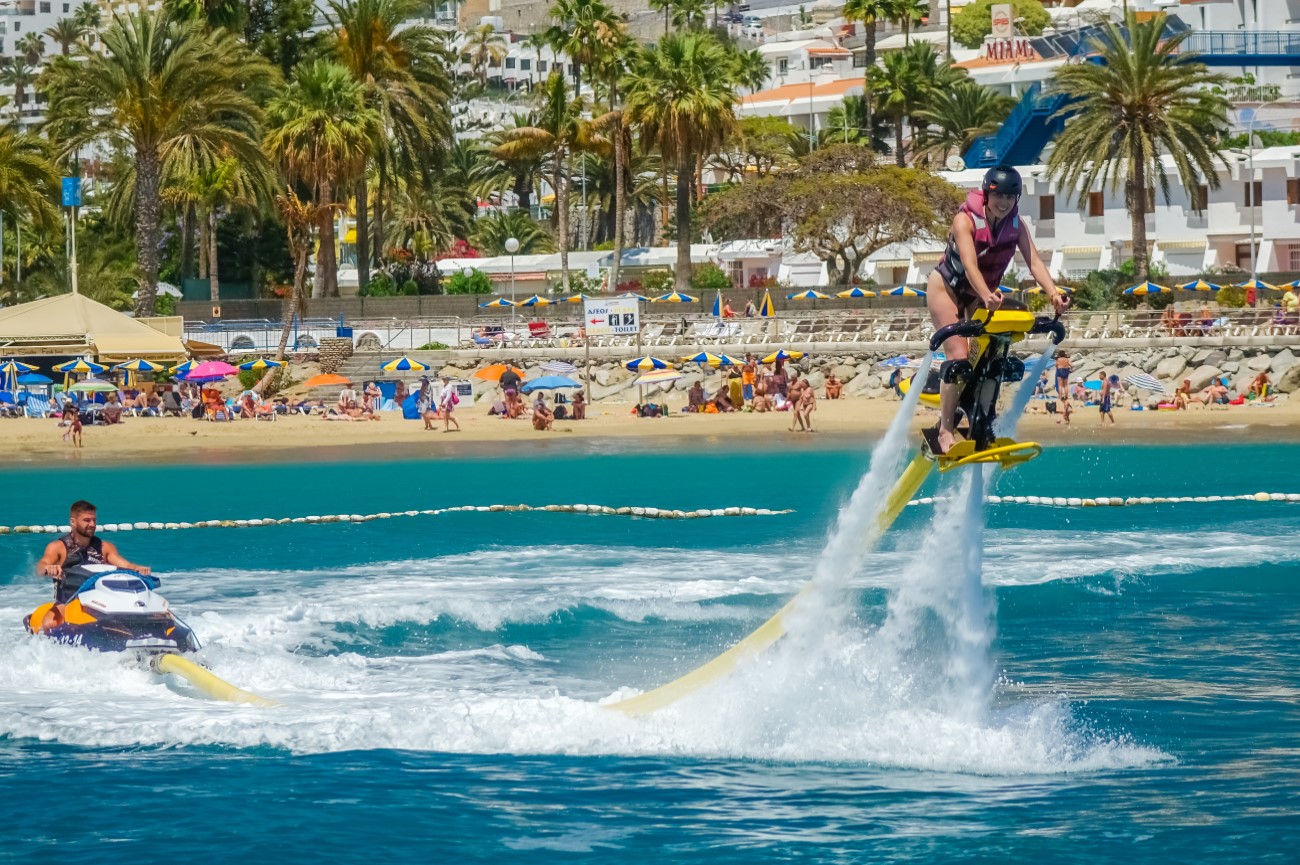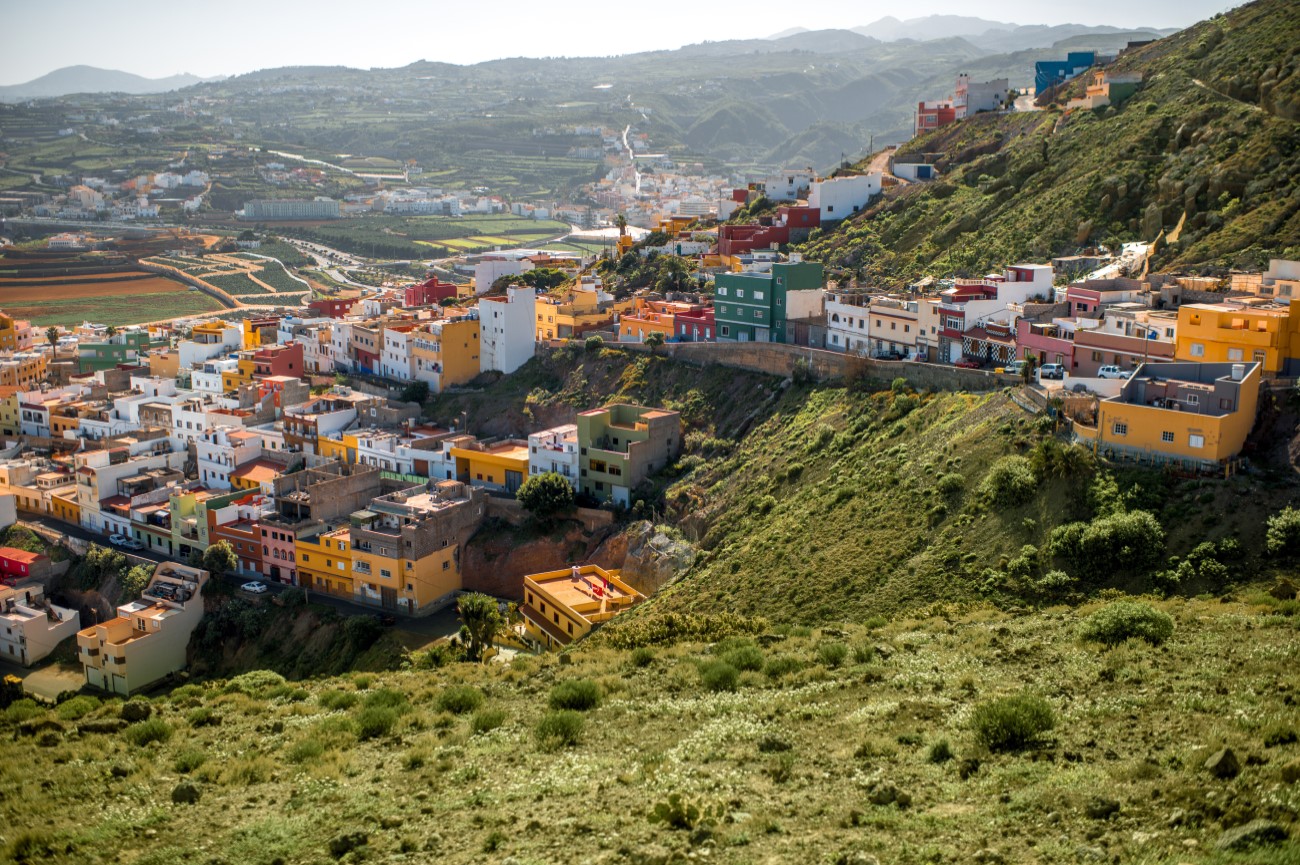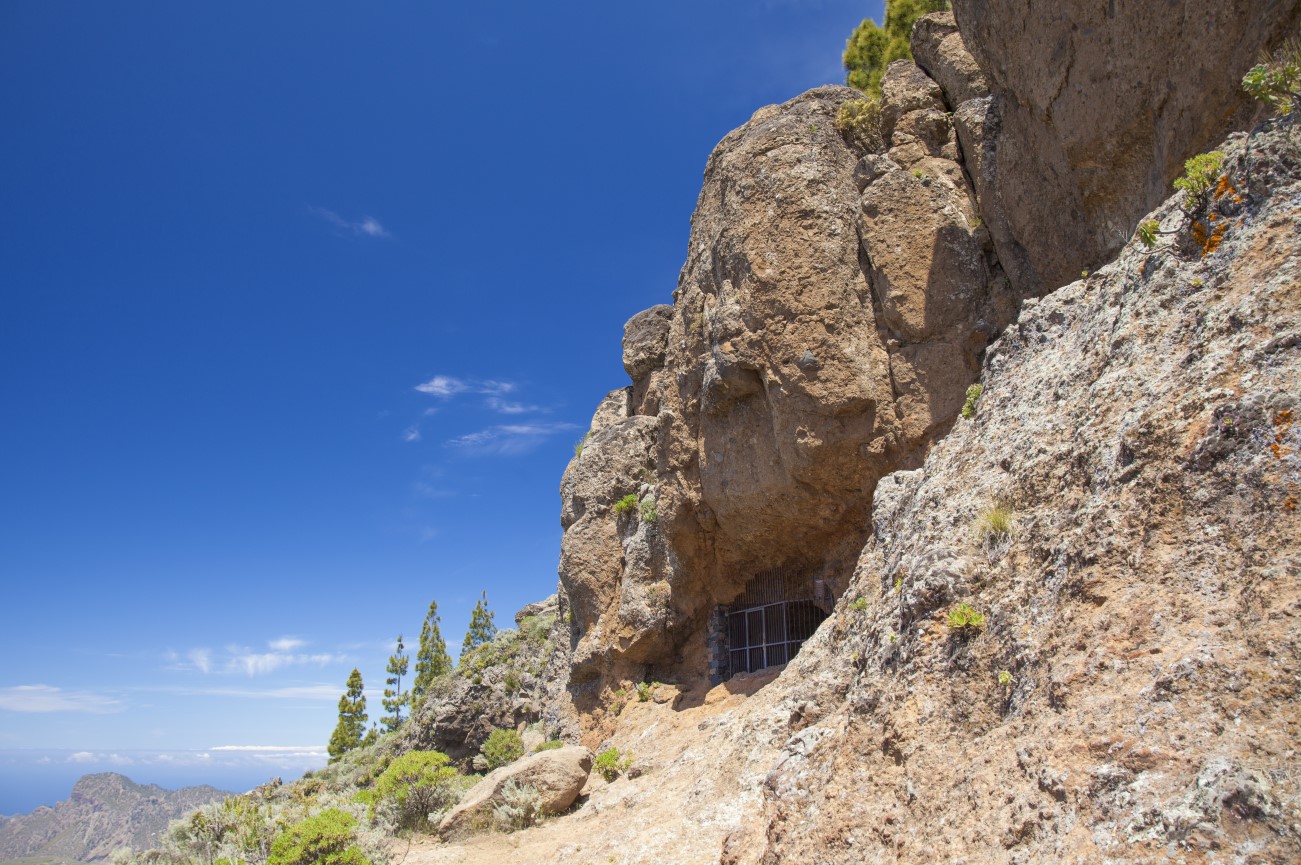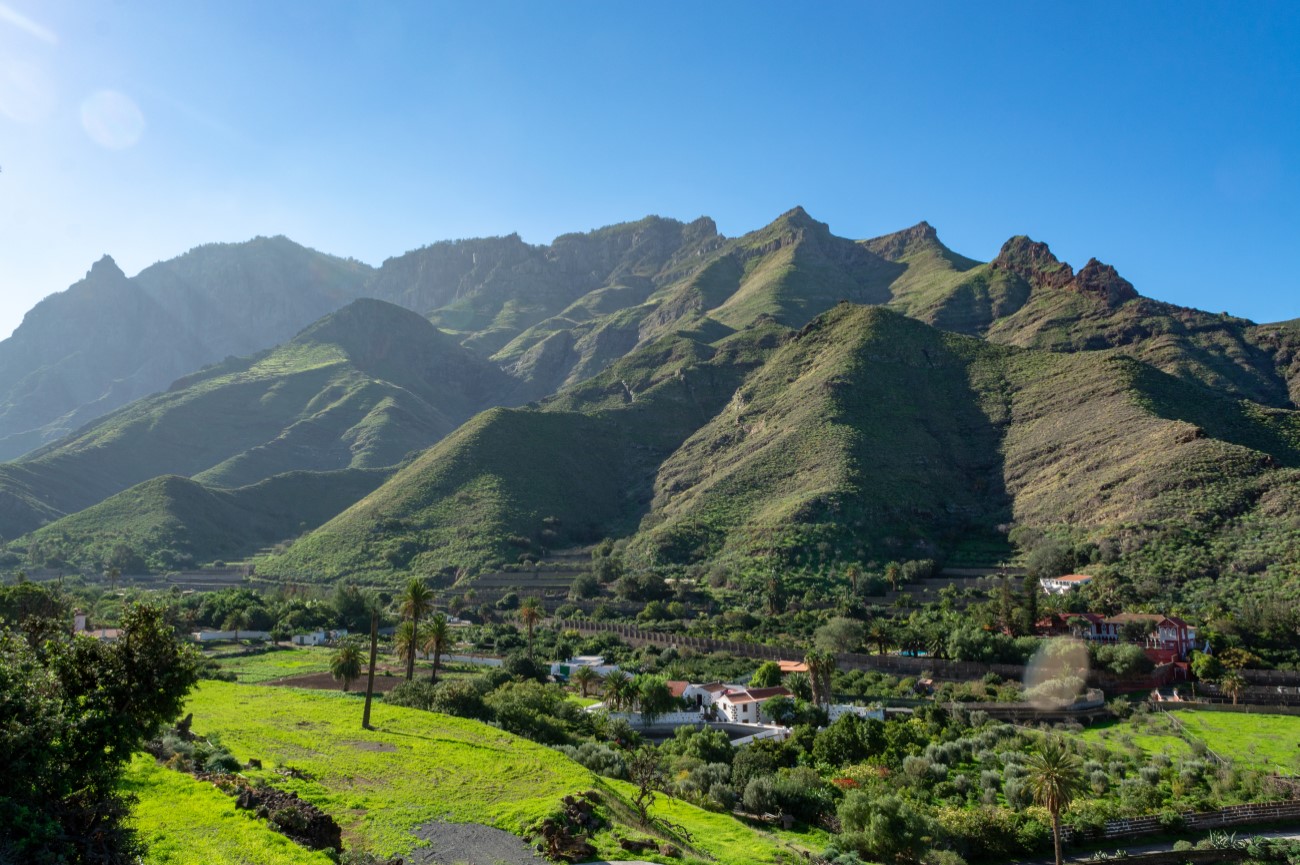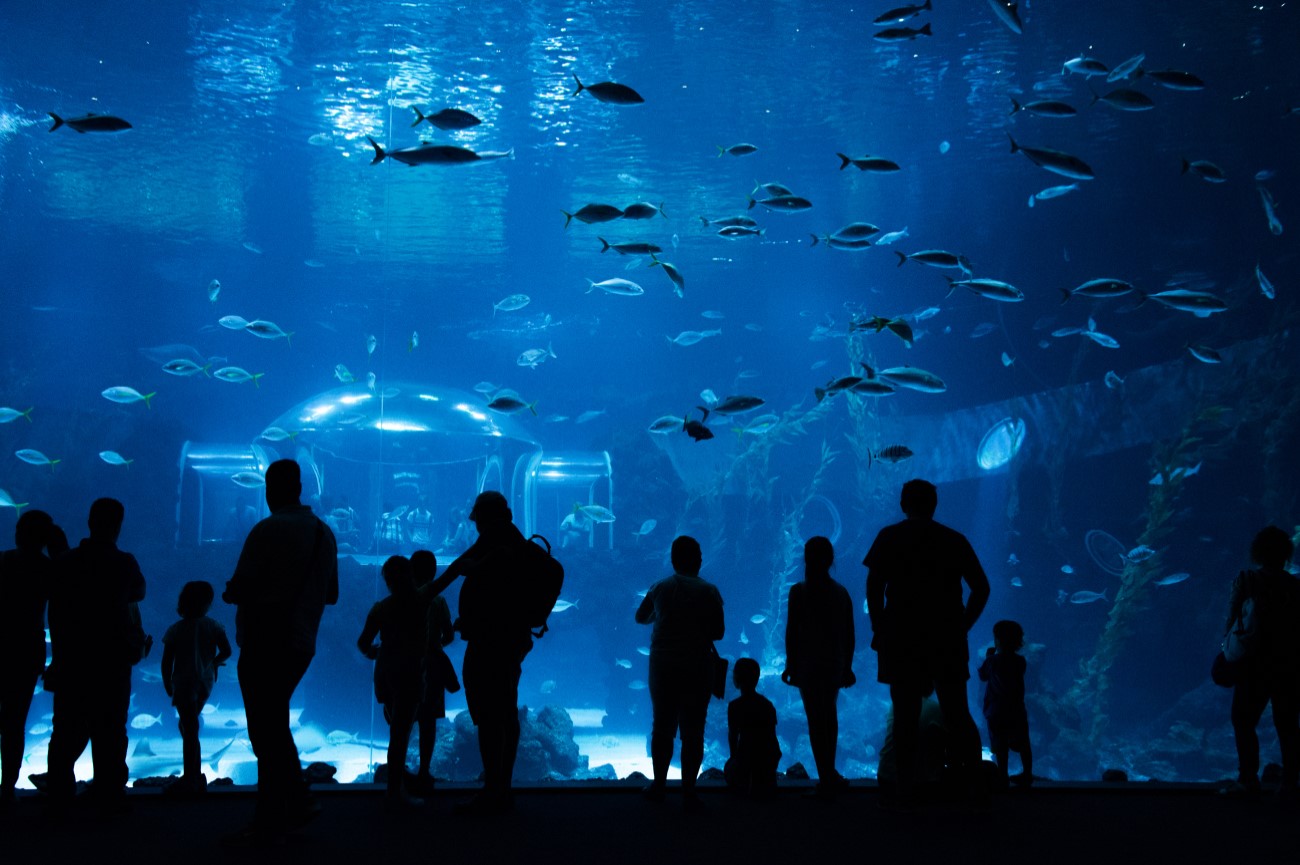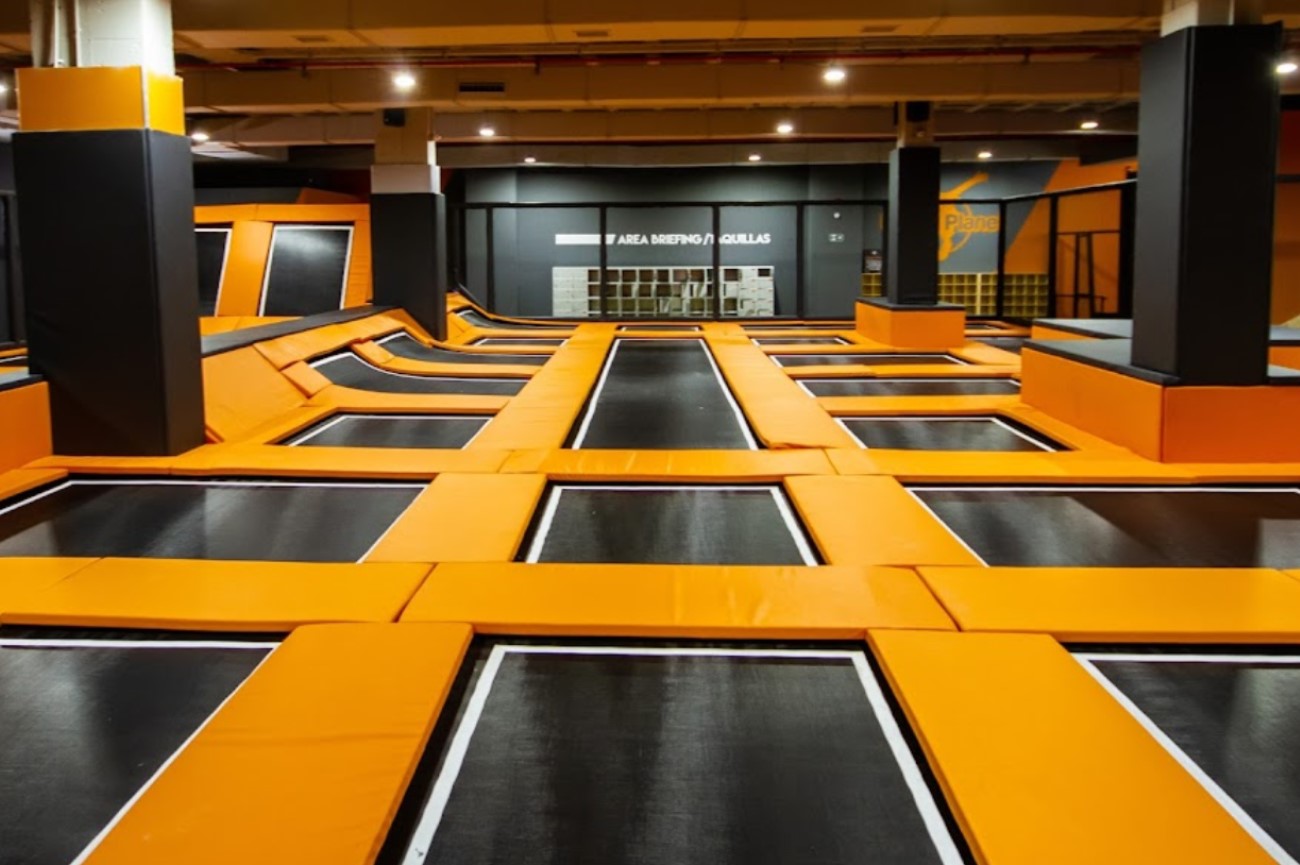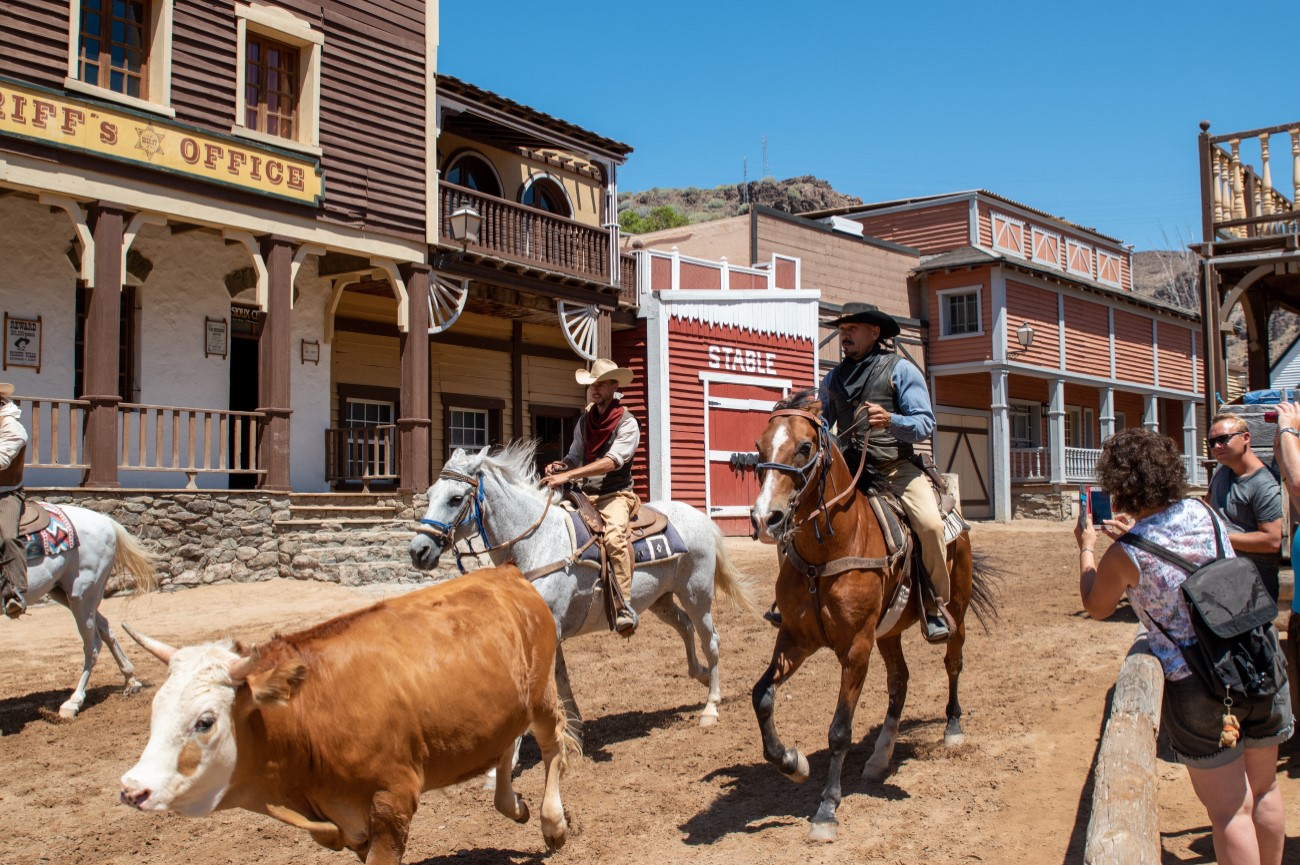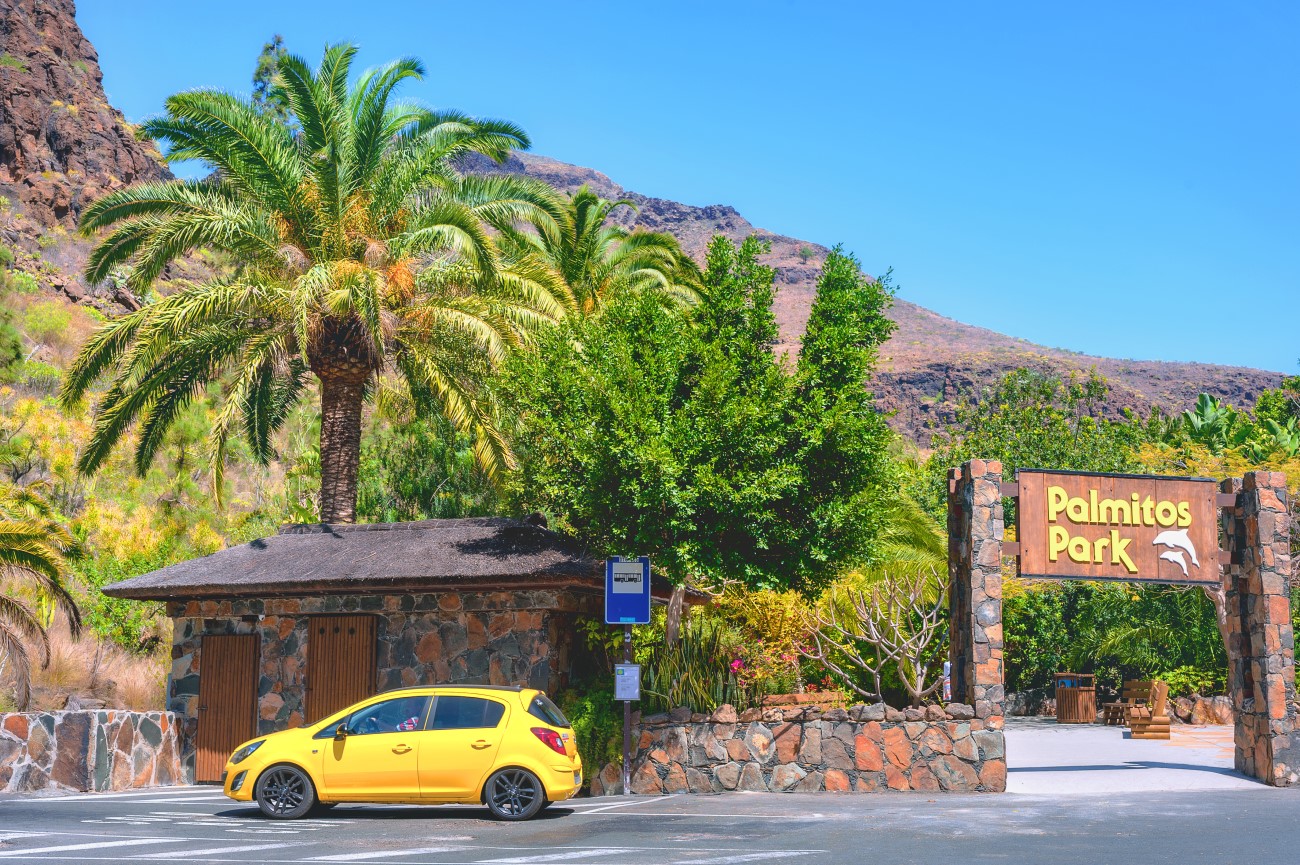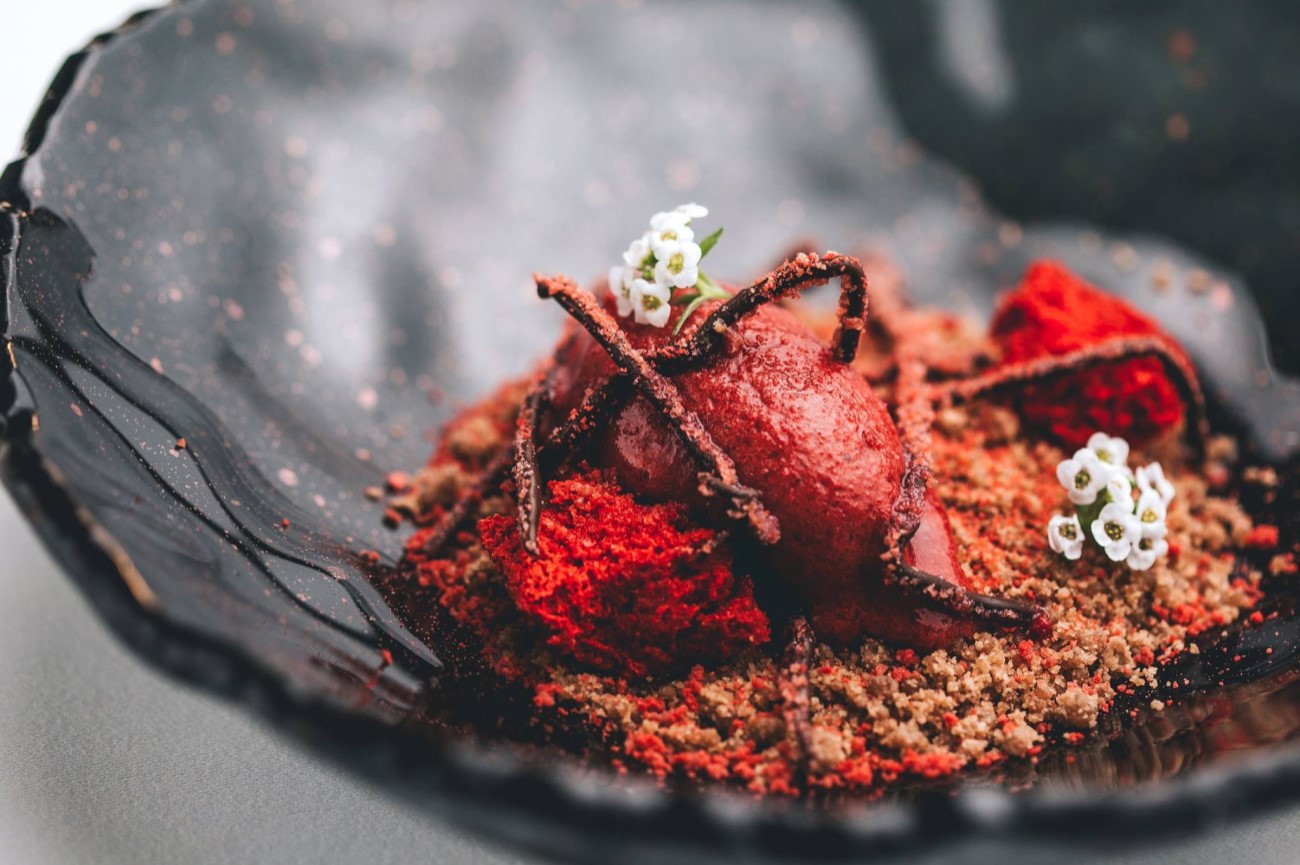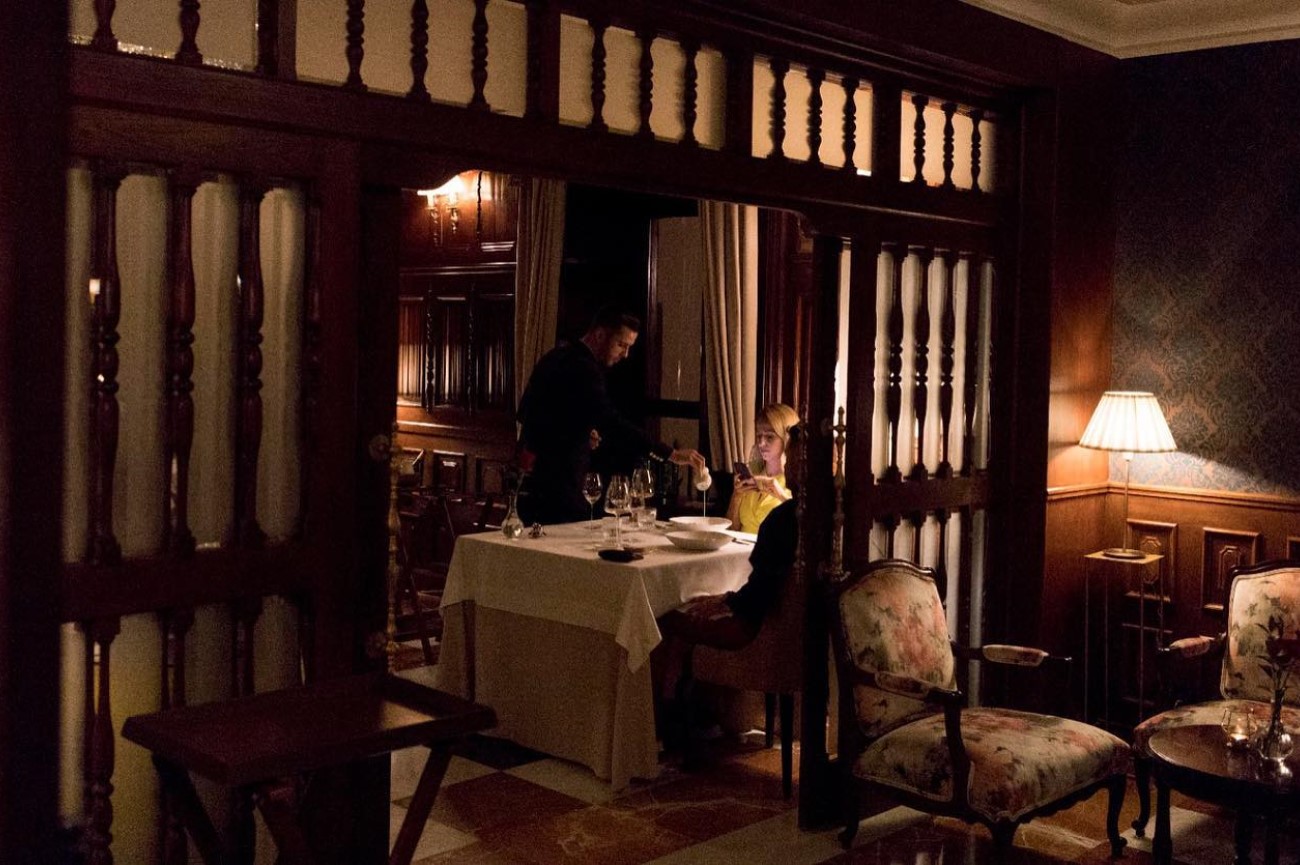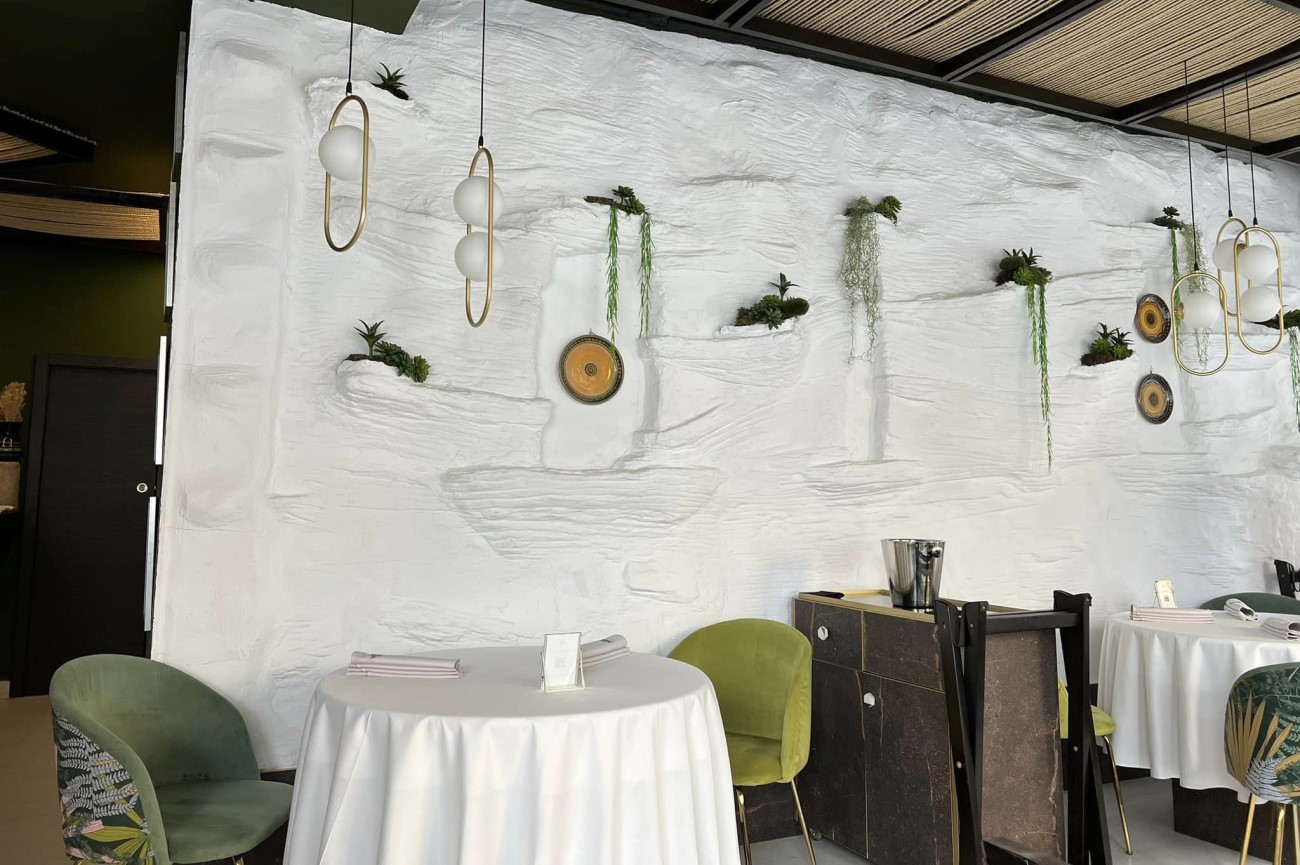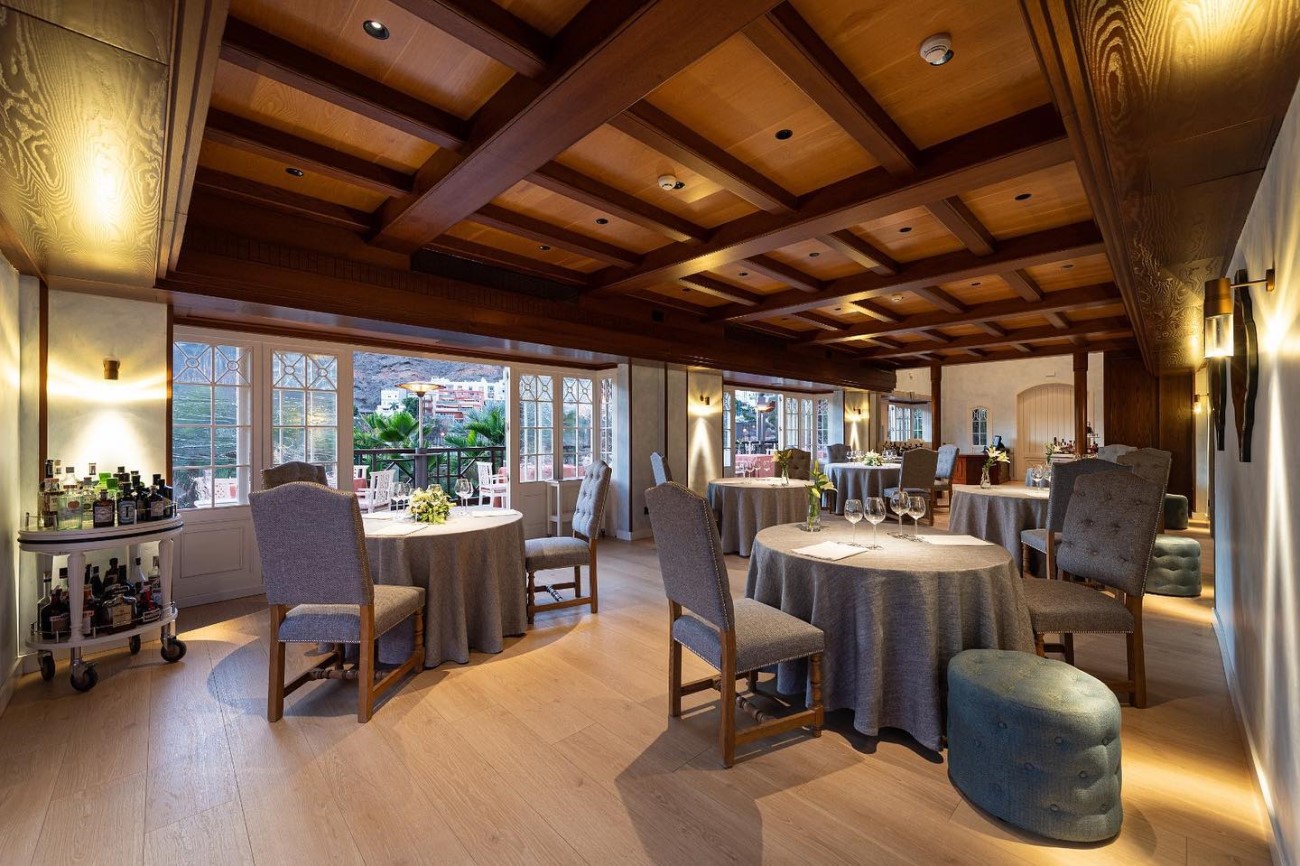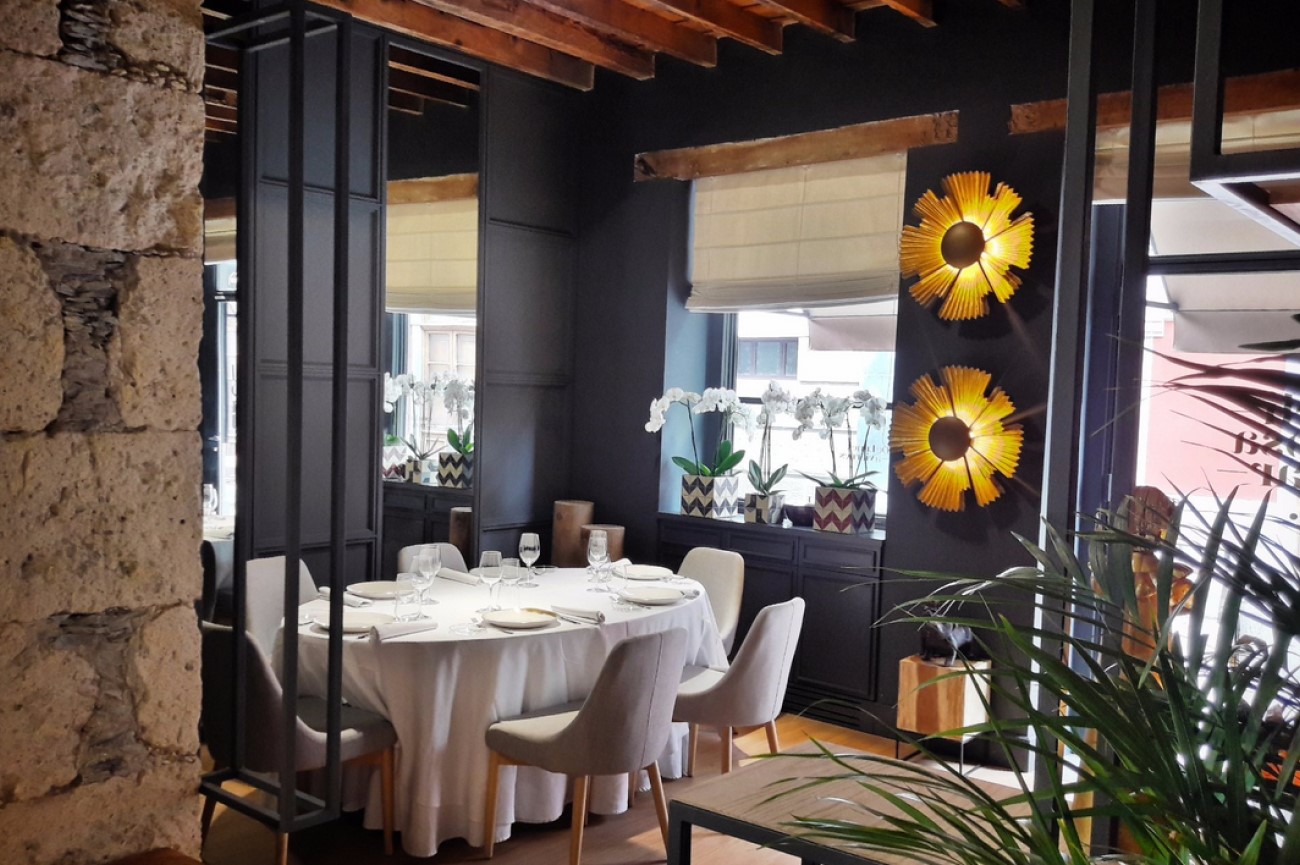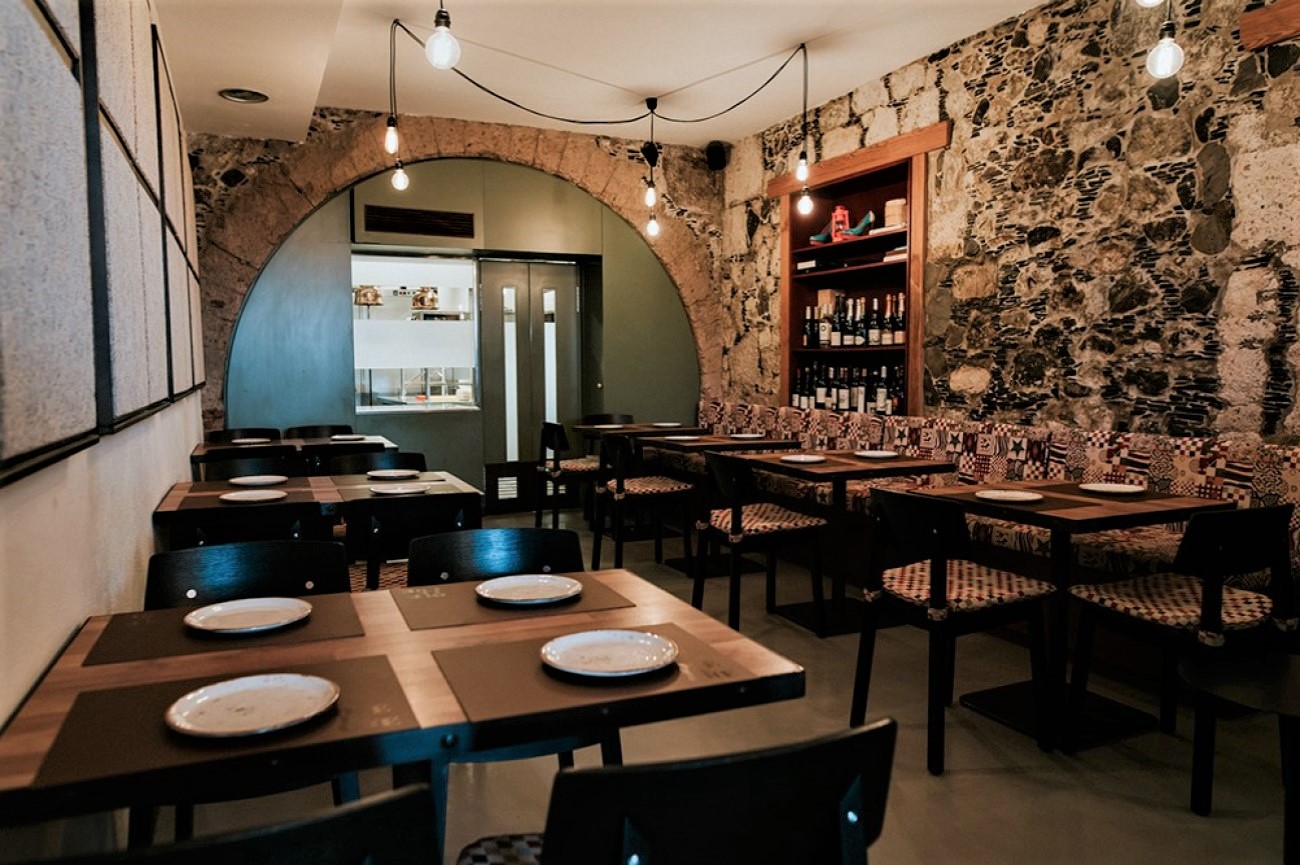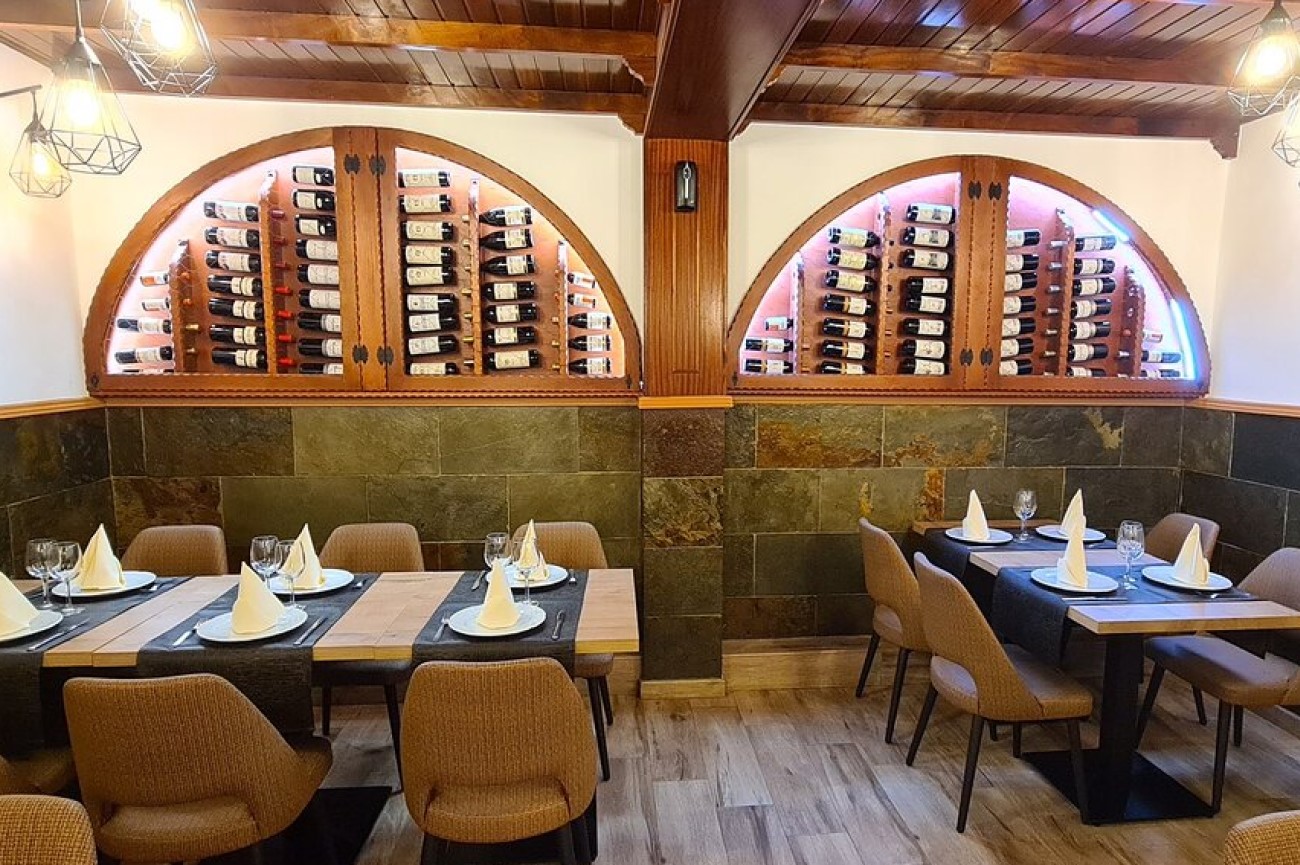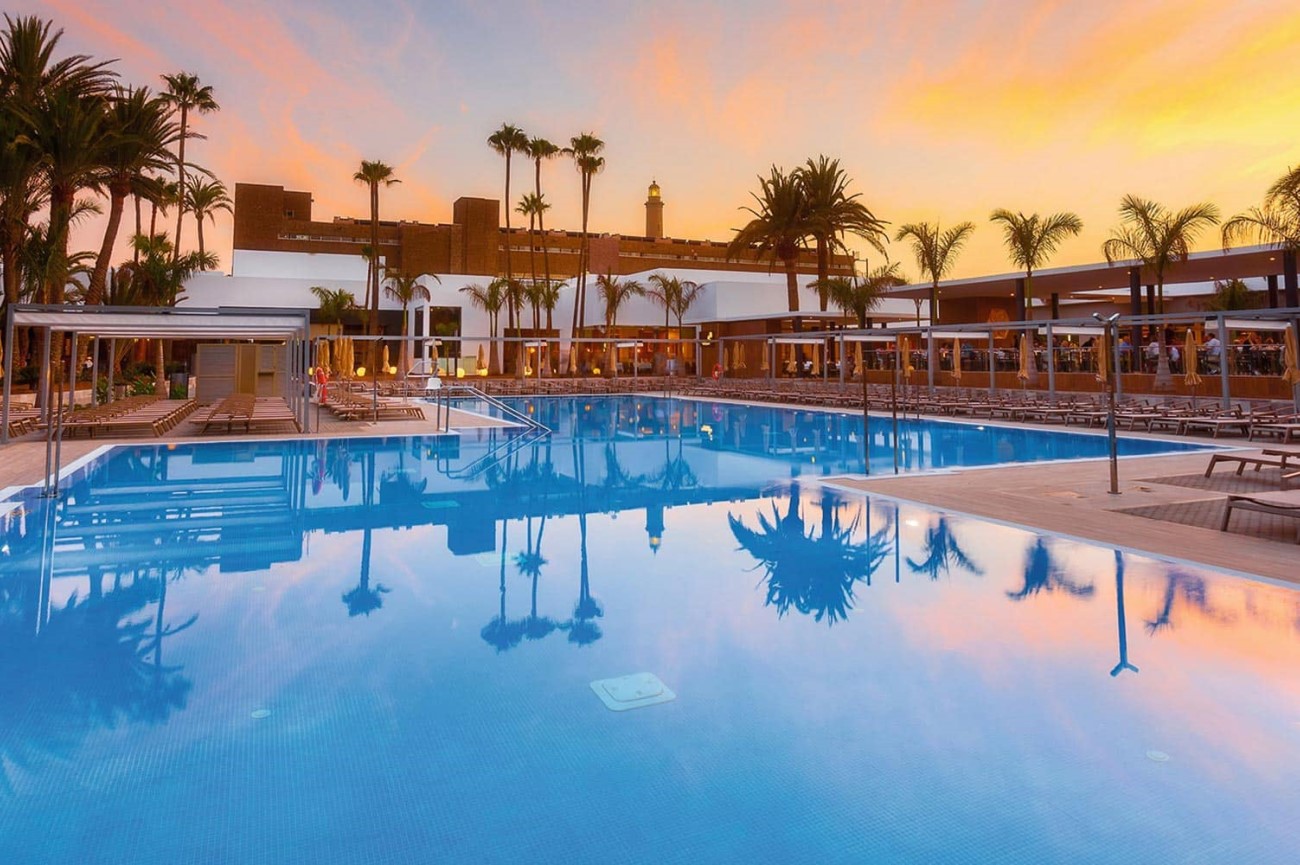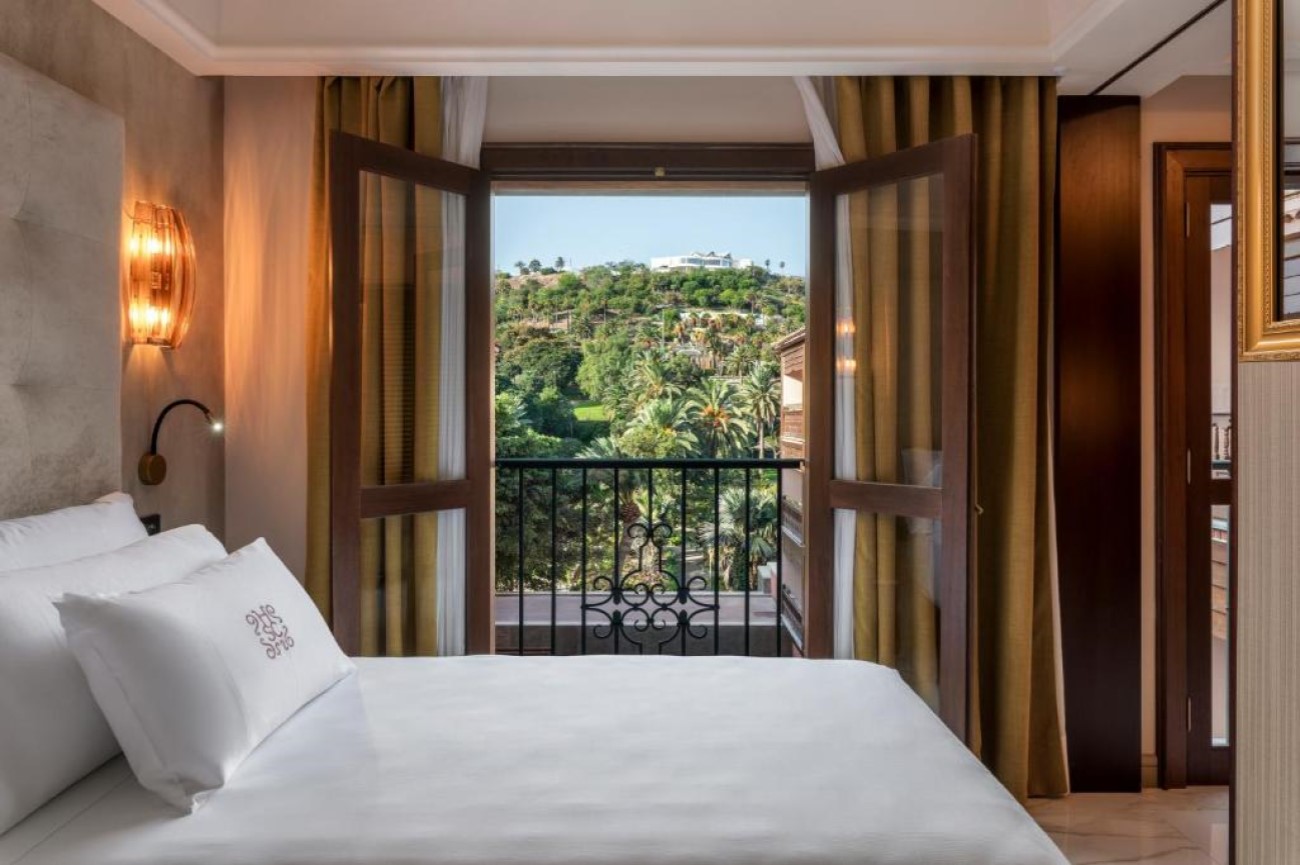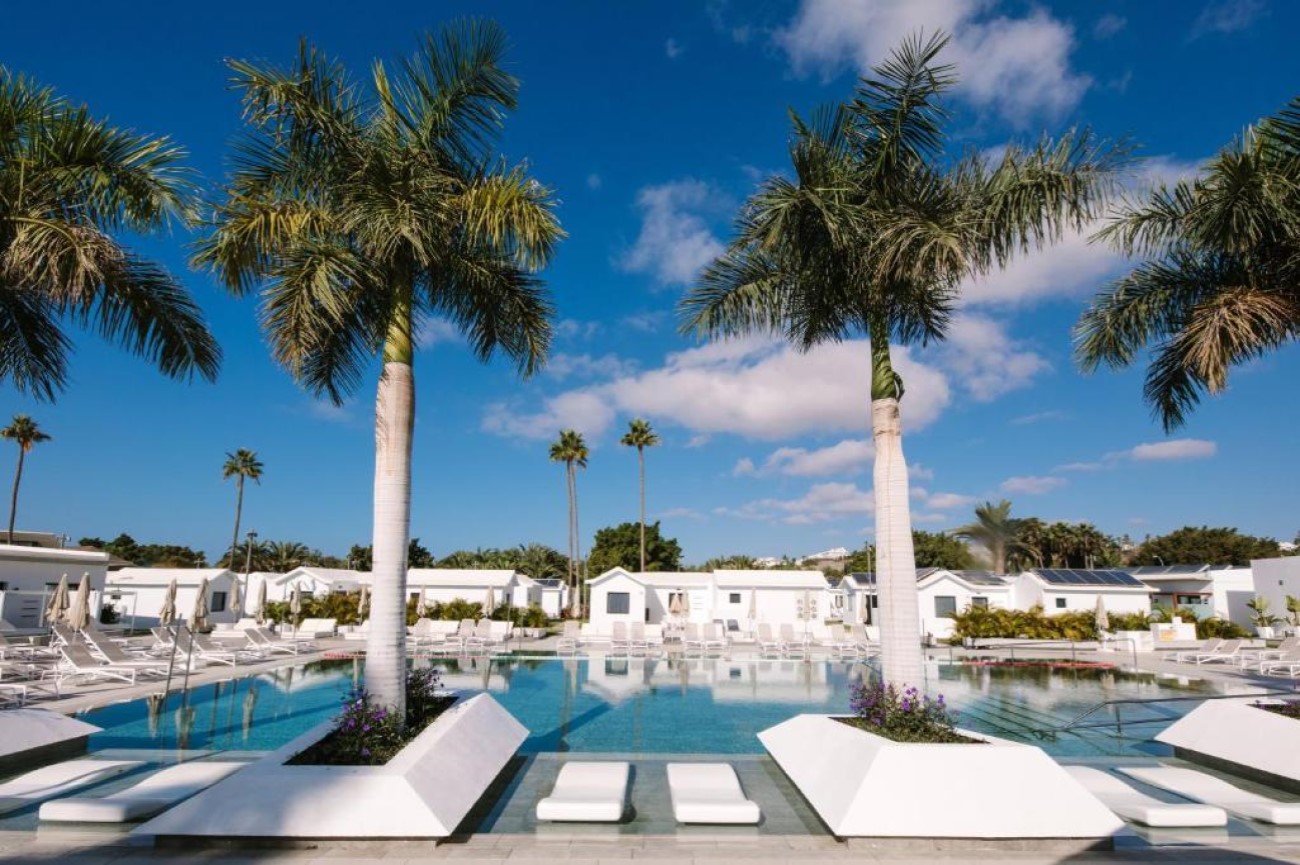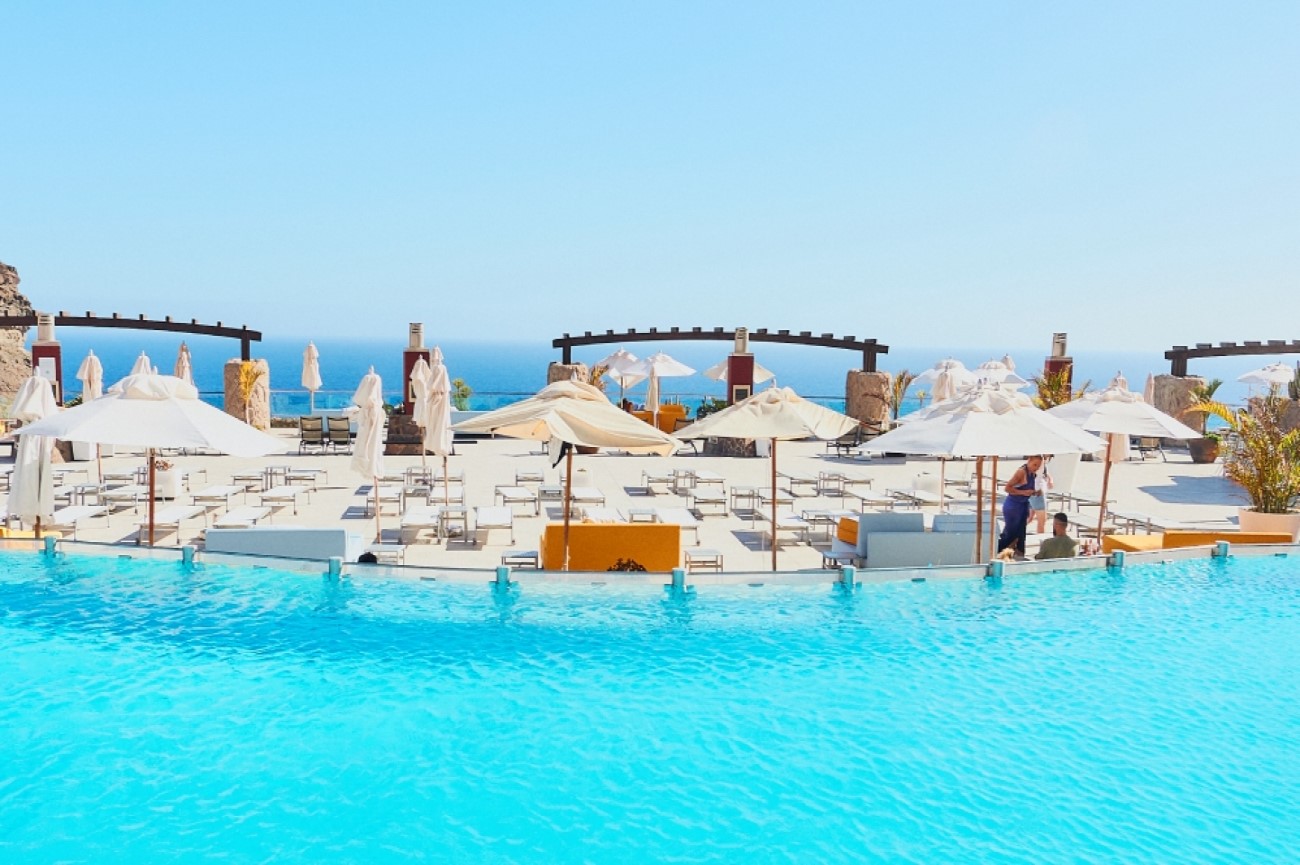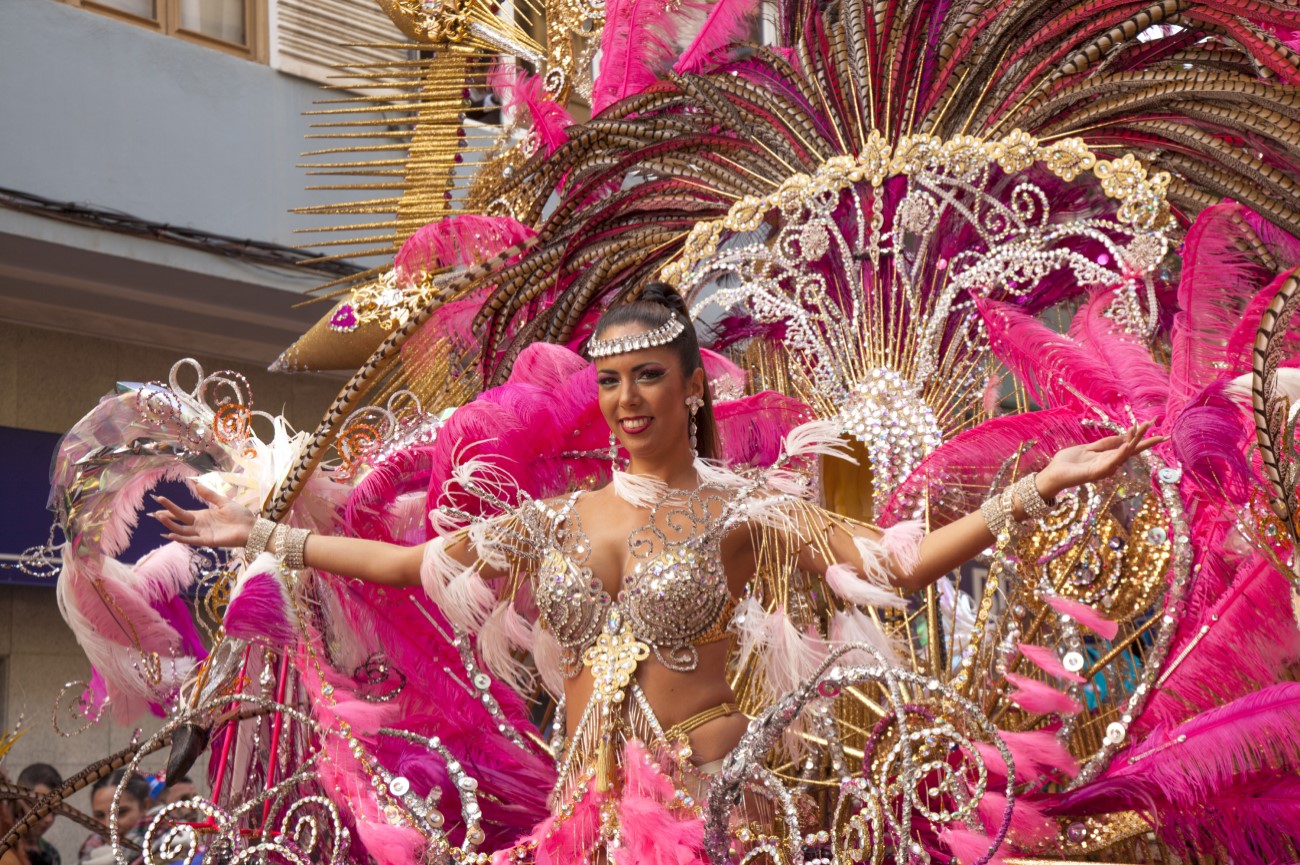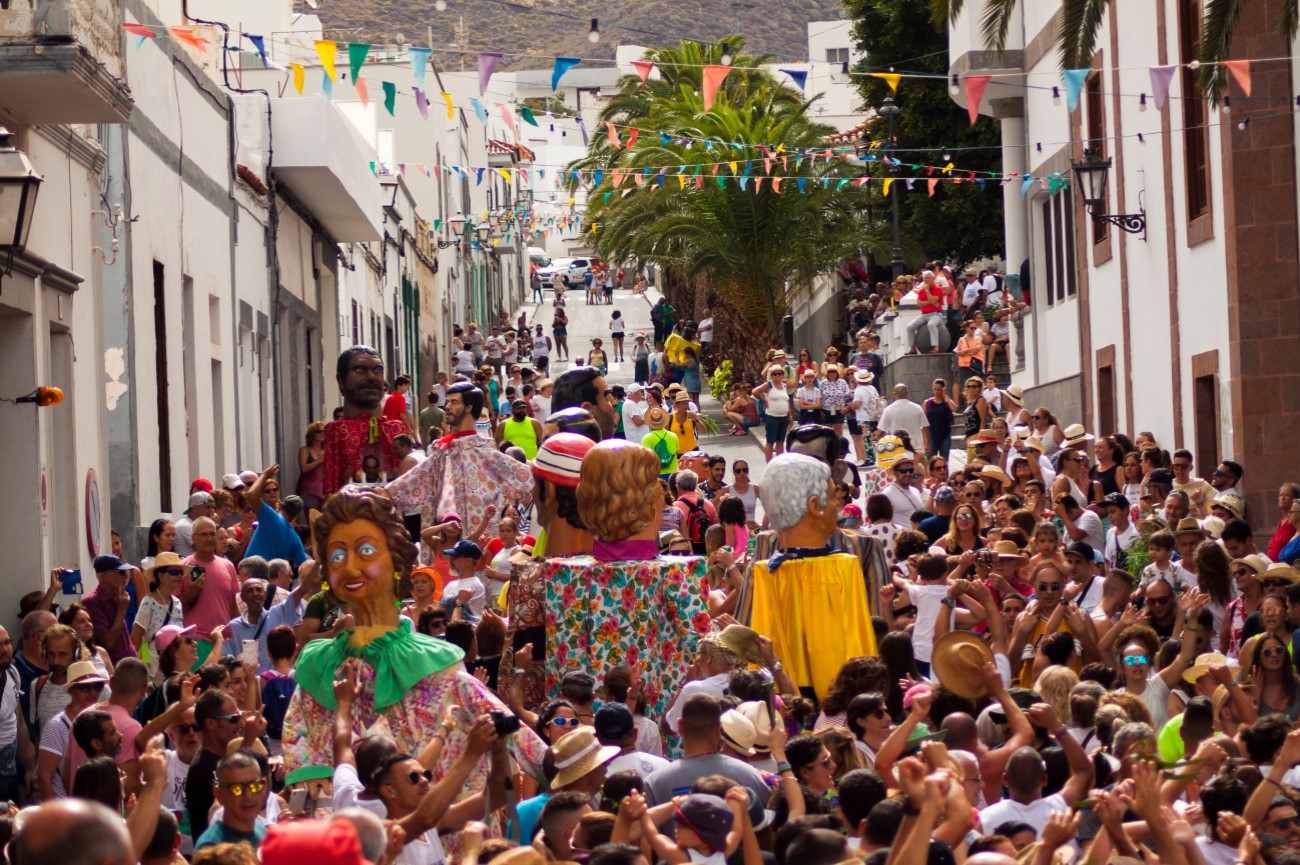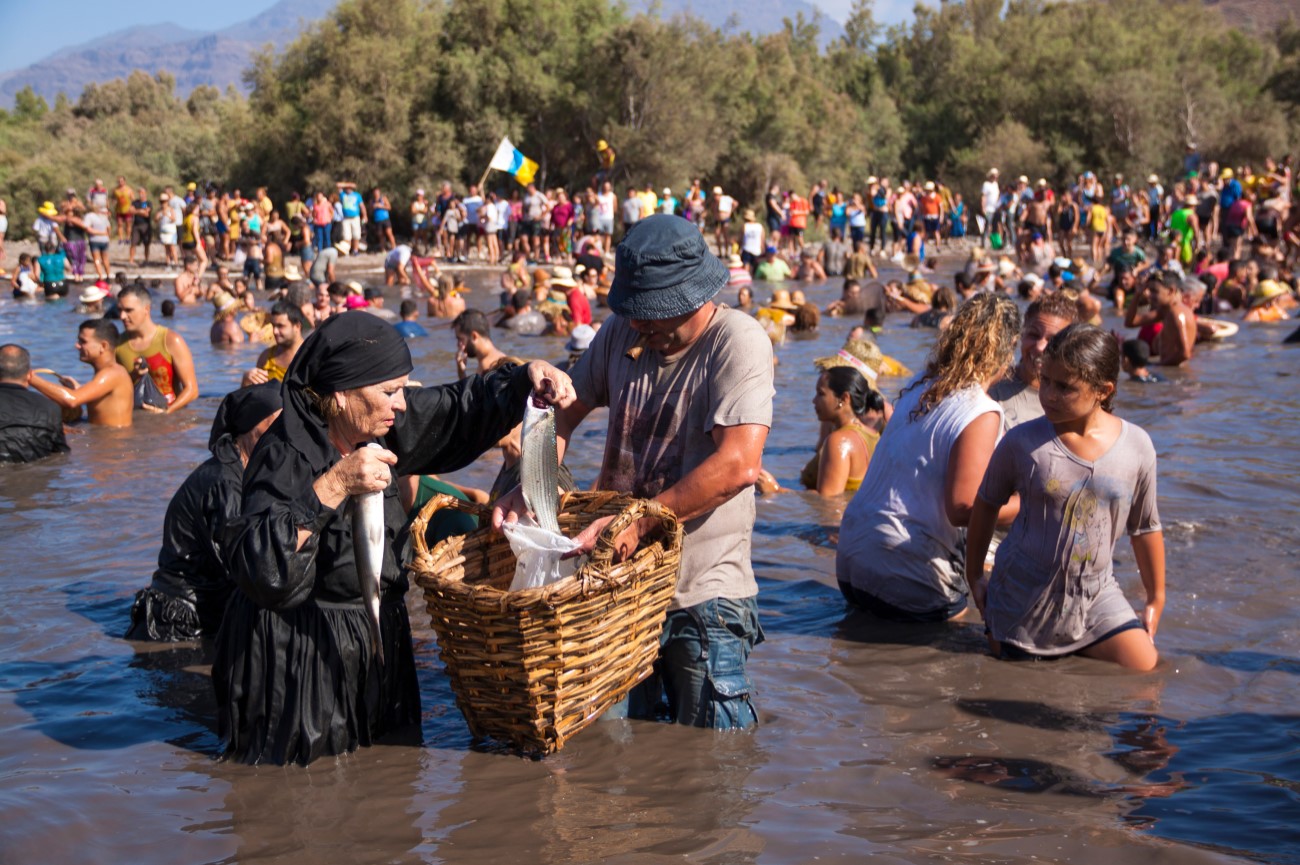Things to do in Gran Canaria, Spain - 5-day itinerary
Gran Canaria is one of the most popular islands in the Canaries, following Tenerife. Almost half of the population of the archipelago lives around here. The island feels like a mini continent, with the landscape changing tremendously from lush mountains to desert-like settings.
Most people head to Gran Canaria for the beach, and there are more than 50 of them to choose from. But beyond the pristine coastline, you’ll also stumble upon mountain villages, ancient caves and historical monuments, especially around the bustling capital of Las Palmas.
Follow our five-day itinerary and discover the best things to do in Gran Canaria, including popular swimming spots and hiking trails.
Day 1 - North

Morning: Firgas
We’re starting our journey on the north side of the island in Firgas. This hilltop town is located 465 metres above sea level. Take your time to wander through the narrow streets. Don’t miss the Paseo de Canarias, where you can admire the 22 coats of arms representing the island’s municipalities and the 19th-century Iglesia De San Roque.
Cenobio de Valerón
A few miles west is the archaeological site of Cenobio de Valerón. Here you can explore up to 350 caves, silos and cavities used to store grain in pre-hispanic times. There’s a path across the site with informative plaques along the way that explain the history of this place and the region’s volcanic roots.
Afternoon: Agaete
Agaete is among the most beautiful villages in the north of Gran Canaria. It sits among Valle Agaete, which is known for its coffee plantations. The houses dotted around the plantations have kept their traditional appearance to this day. It’s worth taking a walk along the maritime walkway facing the beach and visiting the Huerto de las Flores, a charming botanical garden filled with plants from around the world. The village is also a great spot to grab lunch and sample some Canarian cuisine.
Playa Guayedra
After a relaxing break in Agaete is time to hit the road again. The Playa Guayedra is located deep inside the Tamadaba Natural Park. To reach this wild beach, you’ll need to follow a trail which takes around one hour each way. On your way there, you’ll be able to admire the cliffs of Roque Faneque, the Dedo de Dios sea stack and Puerto de las Nieves. Guayedra was recently featured in the Netflix show The Witcher, which has drawn attention to this once-secret spot.
Puerto de Las Nieves
End your day with a swim at the Agaete natural pools in Puerto de Las Nieves. These pools are perfectly safe to swim as they are sheltered from the harsh waves. Then take a walk around the promenade and grab a drink at one of the local bars. Facing slightly west, the town is the perfect spot to catch the sunset.
Day 1 - North Gran Canaria Tour Map
Day 2 - South

Morning: Mirador del Balcón
For our third day, we’re exploring the southwest of the island. The first stop on our itinerary is the Mirador del Balcón. Nestled between the coast and the Tamadaba Natural Park, this viewpoint offers breathtaking views of the ocean and the row of cliffs known as the dragon’s tail. Starting the day here will open your eyes to the incredible landscape ahead.
Playa Güi Güi
Gran Canaria is famous for its wild beaches, and Playa Güi Güii is among the best ones. To reach this remote beach, you’ll have to hop on a boat or walk. The trail is a bit challenging, but every step you take is worth it to see that pristine sandy stretch surrounded by the huge cliffs. The beach sits within the UNESCO Gran Canaria Biosphere Reserve.
Afternoon: Fuente de los Azulejos
Continue your trip to Fuente de Los Azulejos. These rock formations have gained the nickname “fountain of tiles” due to the colourful patterns created by oxidisation over the years. It doesn’t rain much in Gran Canaria, but when it does, waterfalls emerge from the mountains, and you can spot them from the road.
Puerto de Mogán
The fishing village of Puerto de Mogán is one of the sunniest places on the island. It’s hard not to fall in love with this coastal town dotted with whitewashed houses, tropical gardens and canal bridges resembling Venice. Start with a swim at Playa de Mogán. Then get lost in the maze of narrow streets leading to charming squares or the viewpoint overlooking the sea.
Maspalomas
End the day at Maspalomas, the southernmost point on the island. The main attraction here is the Maspalomas Dunes, a desert-like nature reserve featuring ponds, palm trees and 980 acres of sand. Start by visiting Las Dunas Interpretation Centre, located in the Hotel Riu Palace Maspalomas, where you can learn all about the area and then take in the landscape from the nearby viewpoint. After that, follow the trail that crosses through the dunes and leads to Maspalomas Beach. Do not deviate from the path as this is a protected area with several native species, such as the Gran Canaria giant Lizard. Once you’ve reached the beach, you can continue along the coast to the Faro de Maspalomas on your right or the Playa del Inglés on the left.
Day 2 - South Gran Canaria Tour Map
Day 3 - Inland

Morning: Fataga
In the heart of the island, you’ll find Fataga, one of the largest canyons of Gran Canaria. This ravine stretches from the mountains all the way to the sea. Its size is so impressive that it has been called the Grand Canyon of Gran Canaria. It is possible to drive a big part of the ravine stopping in the middle of Fataga to admire the views up close. Alternatively, you can head to the Fataga Viewpoint or further out to Las Yeguas for a more expansive view.
Roque Nublo
Roque Nublo, also known as Cloud Rock, is another striking geological feature on the island. This volcanic rock stands alone at 80m high right in the centre of the Tejeda municipality. It was created during a volcanic eruption and is now one of the most visited locations on the island. To reach this natural monument, you’ll need to drive to Degollada de la Goleta and follow the signposted 1.5km walking trail leading to Roque Nublo.
Afternoon: Pico de las Nieves
Pico de Las Nieves is the highest point in Gran Canaria at 1942 metres high. Its name, peak of snow, was given in the 17th century when islanders built pools to catch the snow around the summit. For the best panoramic views, drive up to the Pozo del Pico de Las Nieves. If you’re feeling adventurous, you can walk further up to the Gañifa Window, a popular spot among photographers.
Mirador de Degollada Becerra
From Pico de las Nieves, make your way to the Mirador de Degollada Bacerra. Standing here, you can admire the gorge that separates Montañas de La Almagria and Las Mejoranas. You can also capture Roque Nublo in the distance, along with Roque Bentayga.
Tejeda
On the east end of the Tejeda volcanic crater, you’ll find the town of Tejeda. Standing at 1050m above sea level, it is one of the most spectacular sights on the island. This hilltop village is perfect for an afternoon stroll. Stop by Dulceria Nublo to sample the island’s regional cakes before heading to the viewpoint to capture the surrounding views of Caldera de Tirajana and the Nublo Rural Park.
Day 3 - Inland Gran Canaria Tour Map
Day 4 - Northeast

Morning: Teror
This tiny village sits right in the middle of the island’s northern mountains. It’s worth taking a walk around Plaza del Teror, a square lined with colourful houses, some of which date back to the 16th century. These stand out with their elaborate wooden balconies. Another highlight is the Basilica de Nuestra Señora del Pino, a charming church dedicated to the island’s patron saint. If you’re around on a Sunday morning, you may catch the town’s market, where you can sample local specialities like the chorizo de Teror.
Arucas
We’re leaving the mountains behind and heading closer to the island’s
capital. But first, we’re visiting the town of Arucas. Take some time to
explore the historic centre, where you’ll find the Iglesia San Juan
Bautista, a Gothic church with striking stonework. Along the way, you’ll
find many stores selling the infamous Ron Arehucas, a type of rum made
in Arucas.
The town is also famous for its greenery. So much so that it has been named the ‘city of flowers’. You can experience this at the Jardines de la Marquesa and the Parque Municipal de las Flores both of which feature hundreds of different plant species.
Afternoon: Las Palmas de Gran Canaria
Spend the afternoon exploring Las Palmas, the capital of Gran Canaria.
This bustling city is packed with historical monuments and plenty of
restaurants where you can sample Canarian cuisine. Begin your tour at
the historic centre, also known as Vegueta.
This 15th-century area is
home to the Santa Ana Cathedral and Plaza de Santa Ana. Other noteworthy
sights in Las Palmas include the Museo Canario, Casa de Colon and the
Vegueta Market.
After visiting these, you can enjoy a stroll along the Botanic Gardens of Viera and Clavijo.
Las Canteras Beach
Just a few minutes from the city is Las Canteras, a golden beach stretching for 3km. Take a walk along the promenade and grab a drink at one of the local bars before catching the sunset.
La Isleta
Continue north, and you’ll end up in the old fisherman’s quarter called La Isleta. It is a great place to escape the crowds and relish the coastal views.
Day 4 - Northeast Gran Canaria Tour Map
Day 5 - East

Morning: Caldera de Bandama
Less than half an hour from Las Palmas you’ll find the Caldera de Bandama, a crater formed five thousand million years ago. It’s possible to get there by car, but you should watch out for the narrow roads and sudden turns. Alternatively, you can book a guided tour. Once you get there, you can enjoy the panoramic views from the top or follow a hike around the rim of the Bandama Volcano, which takes about two to three hours to complete.
El Bufadero
Drive down to the coast to see El Bufadero de La Garita. The area is surrounded by basalt cliffs, lava tubes, and a natural pool that often releases water like a geyser. However, unlike other natural pools, swimming is not allowed due to the fast changing tides.
Afternoon: Barranco de Las Vacas
Next, head to the Barranco de Las Vacas. It’s amid this ravine that you’ll find the Tobas de Colores, a set of tall rock formations which resemble a desert landscape. It is one of the most visited attractions on the island, so you may need to wait a few minutes to get a clear shot of it. The area is also a Starlight Tourist Destination. For a stargazing session, head to the nearby Temisas Astronomical Observatory.
Agüimes
We’re wrapping up our trip at the picturesque Agüimes. The town is famous for its pastel-coloured houses and metal sculptures which adorn the historic centre.
Day 5 - East Gran Canaria Tour Map
Other things to do around Gran Canaria:
- Dolphin watching: Bathed by the North Atlantic, Gran Canaria offers the perfect opportunity for dolphin watching. Several companies organise boat trips to see these friendly species up close. If you’re lucky, you may also spot sea turtles and whales. Many trips depart from Puerto Rico in the south.
- Watersports: There are plenty of water sports to try on the island. Visitors can choose anything from sailing and waterskiing to windsurfing and scuba diving.
- Gáldar: If you’re heading north, it’s worth stopping by Gáldar. This small town was the first capital of Gran Canaria and was home to an ancient kingdom. Remains of that era are still visible in the archaeological park, where you’ll find a painted cave. Other attractions include the Matrix Temple of Santiago de Gáldar, which features a mix of Baroque and Neo-classical elements. Hikers can also follow the Way of St.James, which begins in Maspalomas and ends in Gáldar.
- Cruz de Tejeda – La Culata: This 14.7km trail takes you to some of the best viewpoints around the island. It is considered moderately difficult, so make sure to come prepared. Starting from Cruz de Tejeda, you'll hike up to Mirador Becerra, where the views open up to Roque Nublo and Roque Bentayga. Along the way you'll pass through the Degollada de la Cumbre, El Garañón and Mirador Presa de los Hornos, ending at La Culata.
- Cruz de Tejeda - Cuevas del Caballero: If you’re looking for a slightly easier hike, this 7km trail may be a better option. It begins at the parking lot near the Parador de Cruz de Tejeda Hotel. From there you should follow the signs towards Artenara. After taking in the views from the Tejeda mountain you will head down to Mirador Degollada de las Palomas. Then it's about 45 minutes to the Cuevas del Caballero, a network of cave dwellings that may have been used by indigenous inhabitants for fertility rituals.
- Agaete Valley-Tamadaba Circuit: Starting at the village of San Pedro, this demanding trail takes you through the Agaete Valley. Along the way, you’ll stop by a few other villages and the Presa de los Pérez dam before reaching the pine forest of Tamadaba. You will need a whole day to take on this trail.
- Tilos de Moya: This nature reserve is renowned for its laurel forest. There’s a circular route across the park, which is easy for families to follow. The walk starts at the Los Tilos Interpretation Center, where you can collect a trail map. Alternatively, there are guided tours that take you around the area.
Top things to do with kids in Gran Canaria
Families visiting Gran Canaria will find plenty of activities for kids. You can spend the day relaxing by the beach, book a dolphin-watching tour or hike one of the island’s numerous trails. Beyond nature, there are a few attractions that are suitable for children. In Las Palmas is the Pueblo Canario, where you can see a replica of a traditional Canarian village and learn more about the island’s traditions. Closer to the coast is the Poema del Mar, a large aquarium with separate tanks for shallow-water, deep water and freshwater species. Alternatively, you can head further to the outskirts, where you’ll find the trampoline park, Urban Planet. Maspalomas also has plenty of family-friendly sights, including Sioux City, a theme park inspired by the American Wild West, as well as a zoo and a waterpark.
Where to eat in Gran Canaria
All the Canary Islands offer a similar cuisine, with each island adding their own tweak to a dish. In Gran Canaria, it's common to order papas con mojo (potatoes with red or green sauce) and gofio escaldado (mashed cereals, here served with seafood broth). One thing that’s specific from here, however, is the Flor de Guía cheese, which has a vegetable rennet made from the dry flowers of the Canarian cardoon. Below are some of the best places to eat in Gran Canaria where you can sample some of these delicacies:
- La Aquarela: Located on the south coast, this Michelin-star restaurant focuses on locally-sourced ingredients. The tasting menus include options for vegetarians.
- Poemas by Hermanos Padrón: Set inside the Santa Catalina Hotel in Las Palmas is another award-winning restaurant. It is run by the Padrón brothers, who also own a restaurant in Tenerife. You can order à la carte or try the tasting menu. A stand-out dish is the Eel “Benedictine”.
- Tabaiba: Chef Abraham Ortega is behind this Michelin-star restaurant in the heart of Las Palmas. Considered the best Canarian chef in 2016, Ortega gives a modern twist to some of the island's traditional recipes.
- Los Guayres: Another classic fine dining spot, Los Guayres was among the first restaurants on the island to receive a Michelin Star. Guests can choose a variety of tasting menus, starting at around €110. The restaurant is part of the Cordial Mogán Playa hotel, which is only a few minutes from the Puerto de Mogán coast.
- Restaurante Deliciosa Marta: You’ll find this high-end restaurant within the Triana neighbourhood in Las Palmas. Among their specialities are the truffled gnocchi and the white asparagus.
- Restaurante Que leche!: If you’re in the mood for tapas, head to Qué Leche. It’s worth ordering a few dishes to share, but some of the highlights include the huevos rotos and the suckling pig.
- Grill Casa Miranda: As the name suggests this place focuses on grilled meats. You can choose your favourite cut and then cook it on a hot stone yourself. Don’t leave without ordering one of their homemade desserts.
- Restaurante La Tunera: Located around Telde, La Tunera makes the most of the island’s local ingredients. Here you can sample traditional dishes like potatoes with gofio mojo. They even produce their own vermouth and liqueurs.
Where to stay in Gran Canaria
- Hotel Riu Palace Oasis (5 stars): Set near the Faro de Maspalomas, this five-star hotel offers a variety of amenities, including three outdoor pools, a restaurant, a fitness room and a spa with sauna. Families can also take advantage of the hotel’s kids club.
- Santa Catalina, a Royal Hideaway Hotel (5 stars): Santa Catalina has been welcoming guests since the 19th century. These have included members of the royal family, statesmen and movie stars. Located in Las Palmas, the building stands out with its stone arches and wooden balconies. Guests have access to a restaurant, a spa and a rooftop with a cocktail bar and an infinity pool overlooking the capital.
- Club Maspalomas Suites & SPA (4 stars): This high-end hotel is only accessible to adults. There are a variety of rooms to choose from, including some with private jacuzzis. Other facilities include a restaurant, spa and an outdoor pool. A beach shuttle and bike rentals are also available.
- Hotel Reina Isabel (4 stars): Facing Las Canteras beach, this hotel is ideal for those who want to make the most of the island’s coast. The rooms are spacious and many offer private balconies with ocean views. Guests also have access to a spa, swimming pool and gym.
- Gloria Palace Royal Hotel & Spa (4 stars): Close to Puerto de Mogán this hotel feels a little bit more secluded. From here, you can easily walk to Amadores beach. But there are plenty of facilities to keep you busy inside including 2 restaurants, 4 bars, 2 outdoor pools and a spa with an indoor pool and sauna.
Best time to visit Gran Canaria
The weather in Gran Canaria is pleasant all year round. That said, there are different microclimates across the island. In the south, you’ll get warm and sunny weather pretty much all year, with temperatures ranging from 15º to 35º. Up in the mountains, however, it can drop to 5º or less, especially around Tejeda or Roque Nublo.
Gran Canaria Festivals
- Carnival: Carnival is one of the most popular events on the island. It usually takes place around February or March, depending on Easter. The festivities begin in the capital with a series of events, including parades, comedy shows and competitions. There are also big celebrations around the towns of Maspalomas, San Bartolomé, Agüimes, Agaete and Telde.
- Día de Canarias: All the Canary Islands come together to celebrate this holiday on the 30th of May. The event includes live music, traditional Canarian wrestling and folk performances.
- Bajada de la Rama: Every year around August 4th, the town of Agaete hosts the Bajada de la Rama. Locals carry pine branches from the village to a chapel dedicated to the Virgen de Las Nieves. In the past, aborigines would throw branches in the ocean as a way to usher in the rain.
- Fiesta del Charco: Another aboriginal tradition, the Fiesta del Charco is held in Puerto de La Aldea on September 11th. Locals take a bath fully dressed and try to catch fish with their bare hands.



